How air travel has changed in every decade from the 1920s to today
A history of air travel through the ages
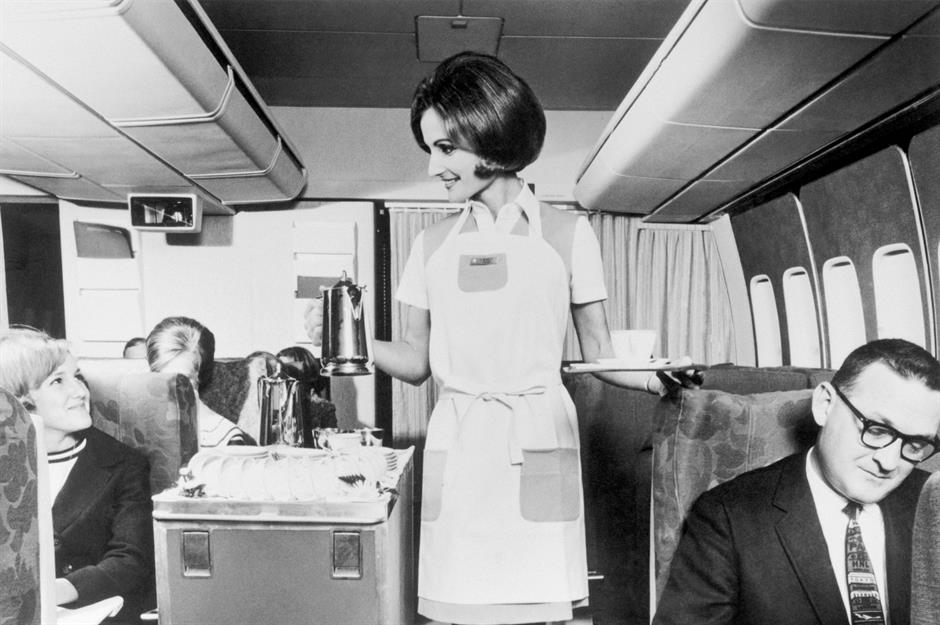
From the early days of flight and the 'golden age of travel' to modern-day budget airlines and the restrictions of the 2020 pandemic, air travel has changed a lot over the past century. Here, we take a journey through time to bring you the biggest milestones in commercial aviation history, including the recently announced plans for air travel to become net zero by 2050.
Click through the gallery to see how air travel has evolved...
1920s: passengers wait to board a plane in 1929
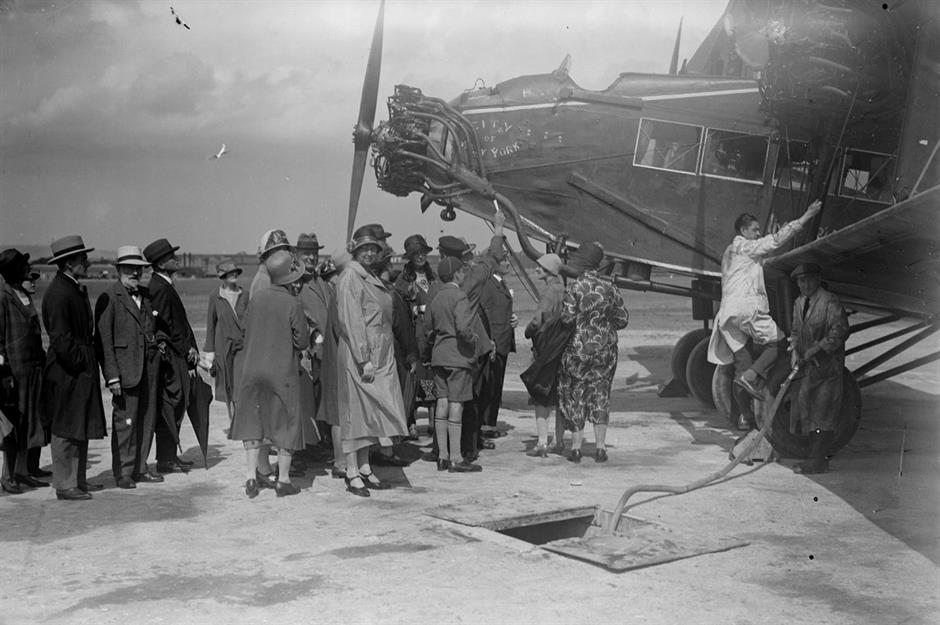
The story of commercial air travel begins before the 1920s, in 1914, when the world's first scheduled passenger service set off between Tampa and St Petersburg, piloted by Tony Jannus. Though commercial aviation did not take off quickly, more and more companies tried to build on this milestone through the 1920s, with varying degrees of success. Here, passengers wait at Croydon Airport, UK to board a Handley Page W.9 aircraft, a model used by early airlines Imperial Airways and Sabena.
1920s: a Western Air Express airliner in 1928
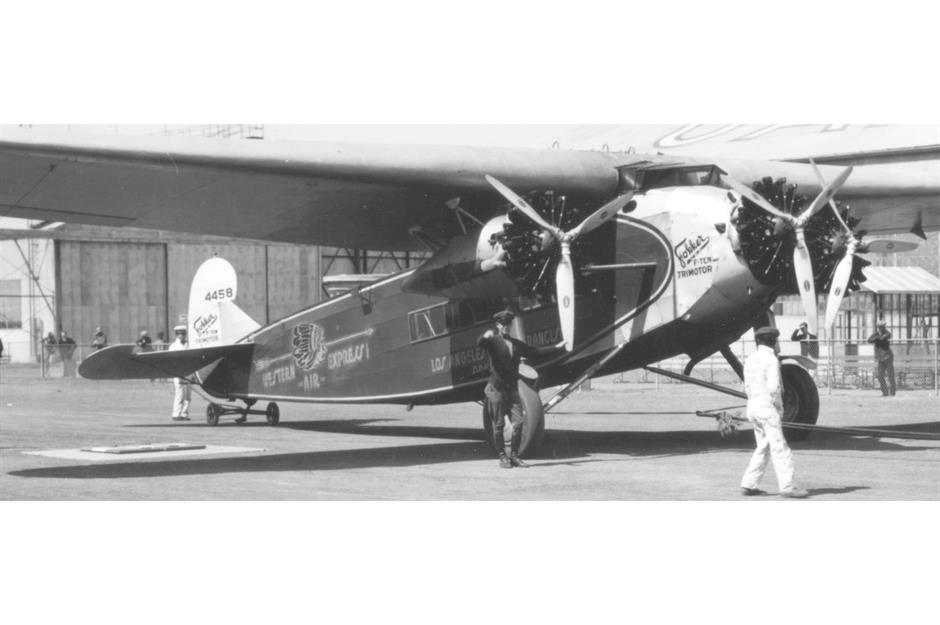
Throughout the 1920s and 1930s, it became common for mail to be transported by air, and many airmail aircraft would also carry passengers. One such airline was Western Air Express, which merged with Trans World Airlines (TWA) in 1930, later acquired by American Airlines in 2001. The airline carried its first load of mail in April 1926 and was welcoming passengers by May of the same year – this first route was Salt Lake City to Los Angeles via Las Vegas. A Fokker F-10 Western Air Express plane is pictured here in 1928.
1920s: Lady Heath pilots a plane for KLM Royal Dutch Airlines
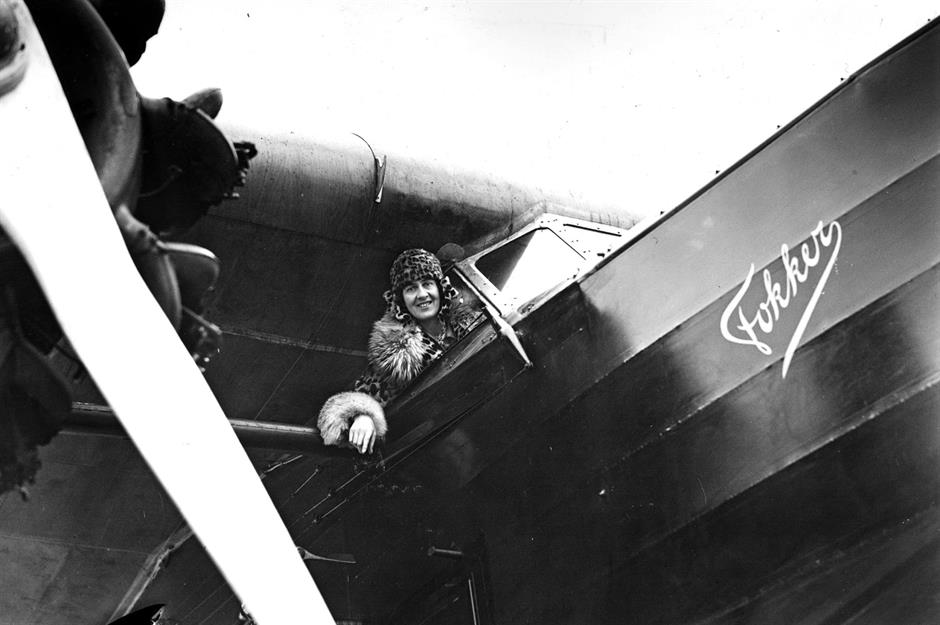
1920s: well-dressed passengers onboard a German Fokker plane
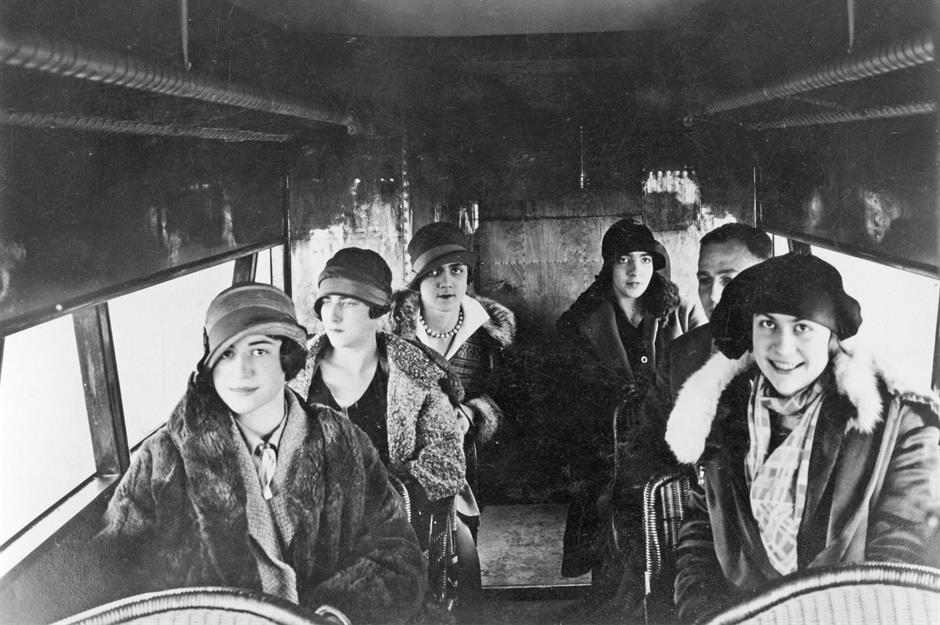
Life onboard a 1920s aircraft was very different from that of the modern day. Flights were a lavish affair reserved only for the richest members of society (as these well-dressed passengers, with their glamorous hats, demonstrate). Those lucky enough to fly to their destination had their every need attended to and were waited on with fine food and drink. However, the ride itself wouldn't have been so comfortable. Planes travelled at a much lower altitude, so passengers were subjected to lots of noise, turbulence and long journey times.
1920s: an early in-flight movie in 1925
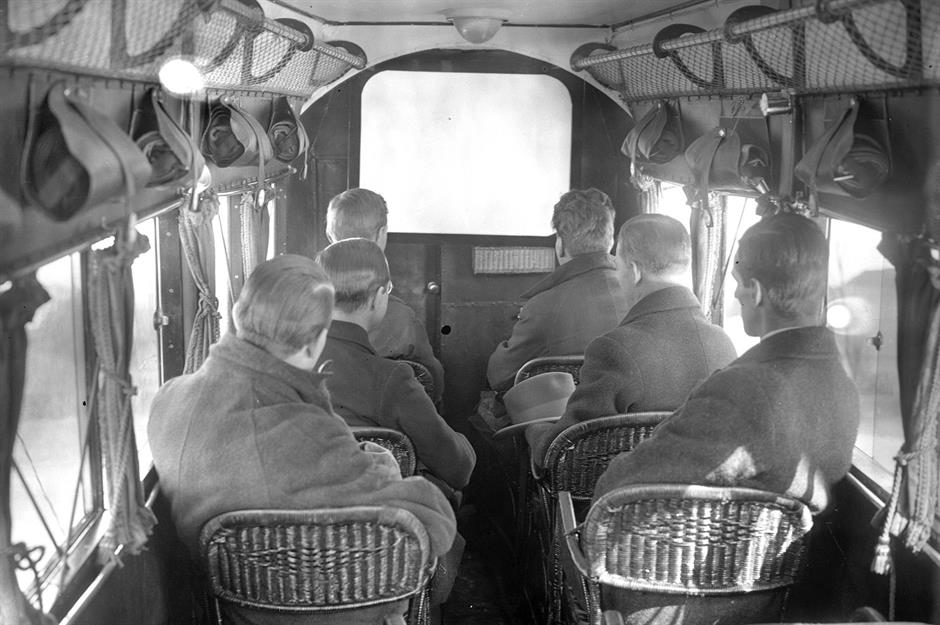
In-flight entertainment systems looked rather different too. Today aeroplane entertainment is a solitary, hi-tech affair but, in the early days of flight, passengers would typically gather around a single screen if they wanted to catch a movie. One of the earliest films to be shown up high was Sir Arthur Conan Doyle's The Lost World in 1925 with Imperial Airways. Here, passengers on a German airliner also enjoy a movie in the year 1925.
Love this? Follow our Facebook page for more historic travel features and inspiration
1930s: a woman hands over an airmail parcel to Western Air Express staff circa 1930
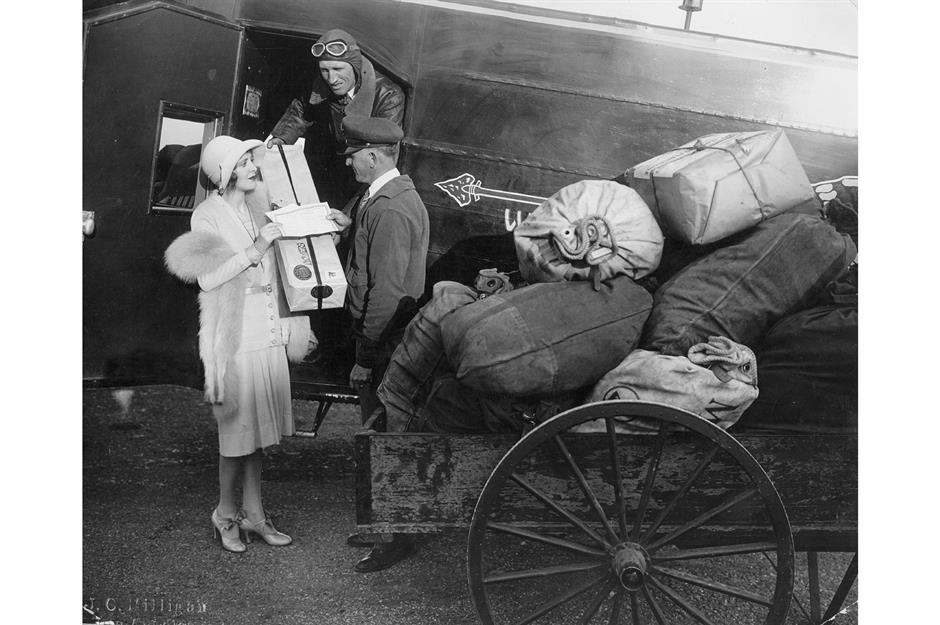
The early 1930s continued in a similar fashion to the 1920s, with airlines offering airmail delivery services and also carrying passengers. Flying was still extremely expensive and fairly uncomfortable but, according to the Smithsonian National Air and Space Museum, the number of airline passengers grew from 6,000 in 1930 to 450,000 in 1934. Here, a woman passes on her mail to the crew of a Fokker F-10 monoplane operated by Western Air Express.
1930s: passengers listen to a broadcast aboard a flight in 1931
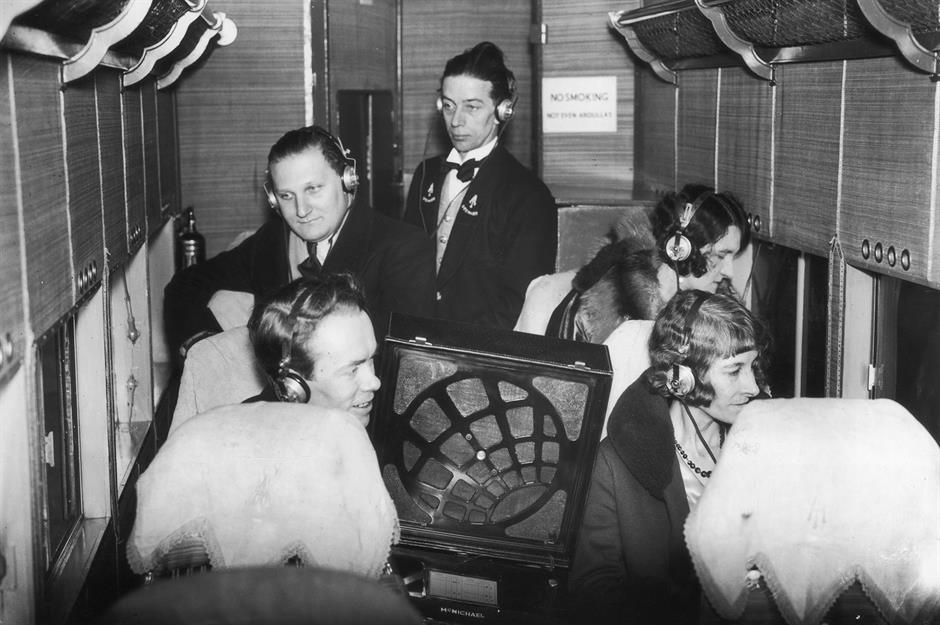
1930s: an early Anglo-Australian airliner in 1934
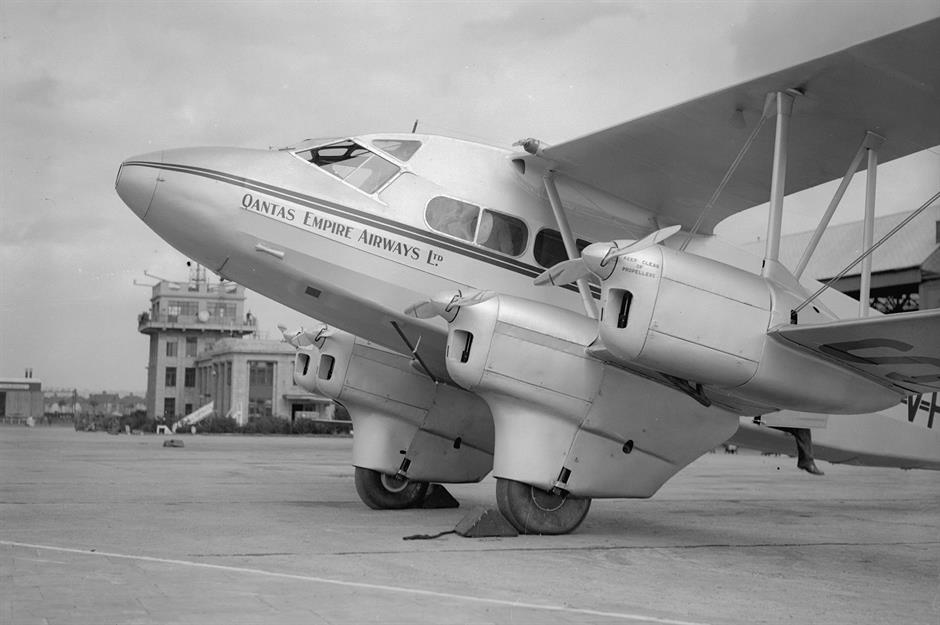
Another commercial aviation milestone was reached in 1935, when Qantas operated its first international passenger flight. The service travelled from Brisbane to Singapore, where it was picked up by British-owned Imperial Airways. This journey would set the foundations for travel between Australia and the UK in the coming decades, and was a precursor to the iconic 'Kangaroo Route'.
1930s: Eastern Air Lines stewards in the 1930s
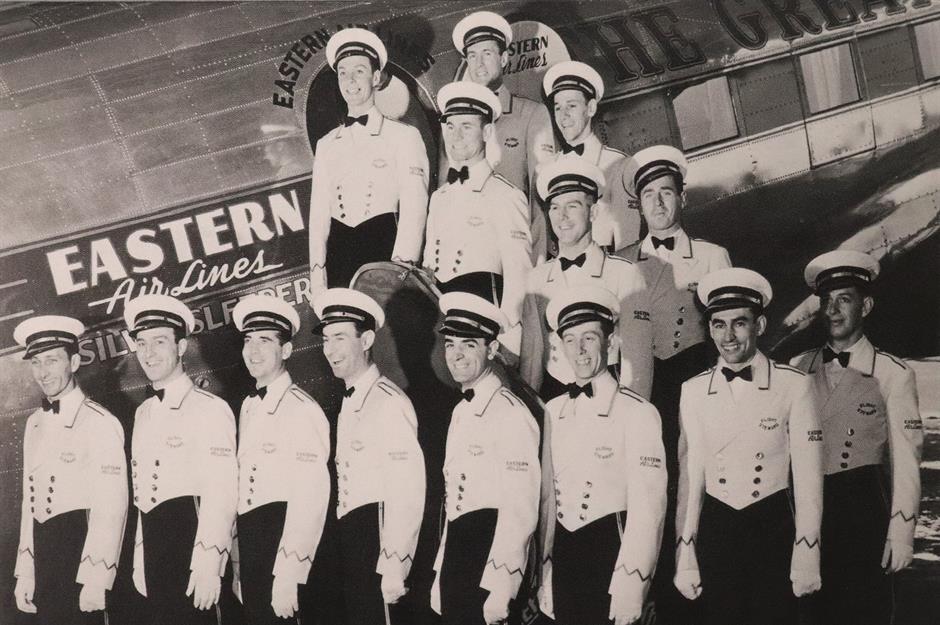
In the 1920s and into the early 1930s, the role of flight attendant was one mostly reserved for men, who were usually referred to as 'cabin boys'. This was soon flipped on its head, though. The first female flight attendant, a nurse named Ellen Church, was employed in 1930 and by the middle of the decade most of these jobs went to women. The women were often trained nurses and there were also strict rules as to their age, height and weight. Before this change, this photo shows an all-male team of air stewards posing before an Eastern Air Lines plane in the early 1930s.
1930s: an Imperial Airways cabin in 1935
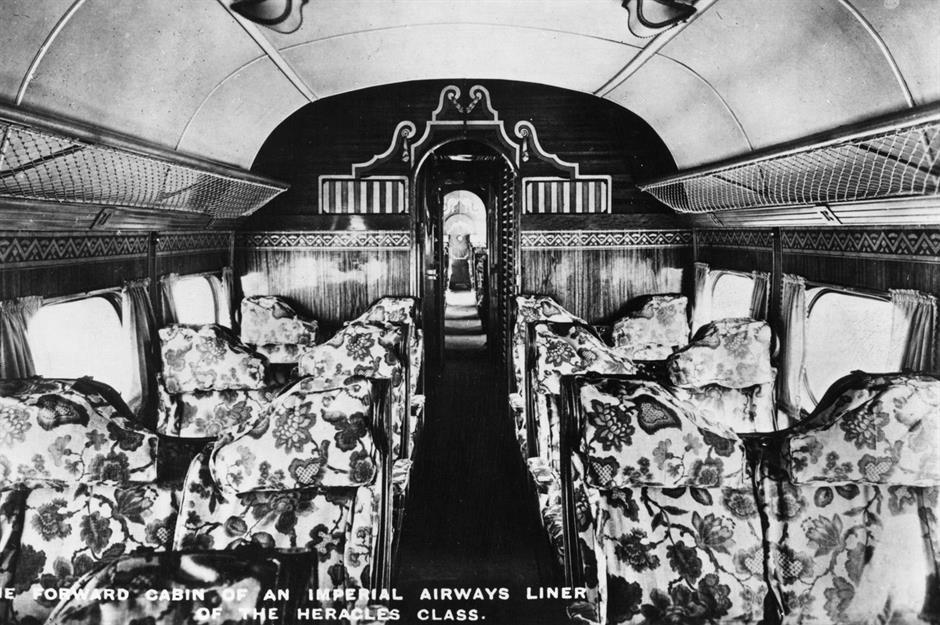
1930s: a Douglas DC-3 in flight
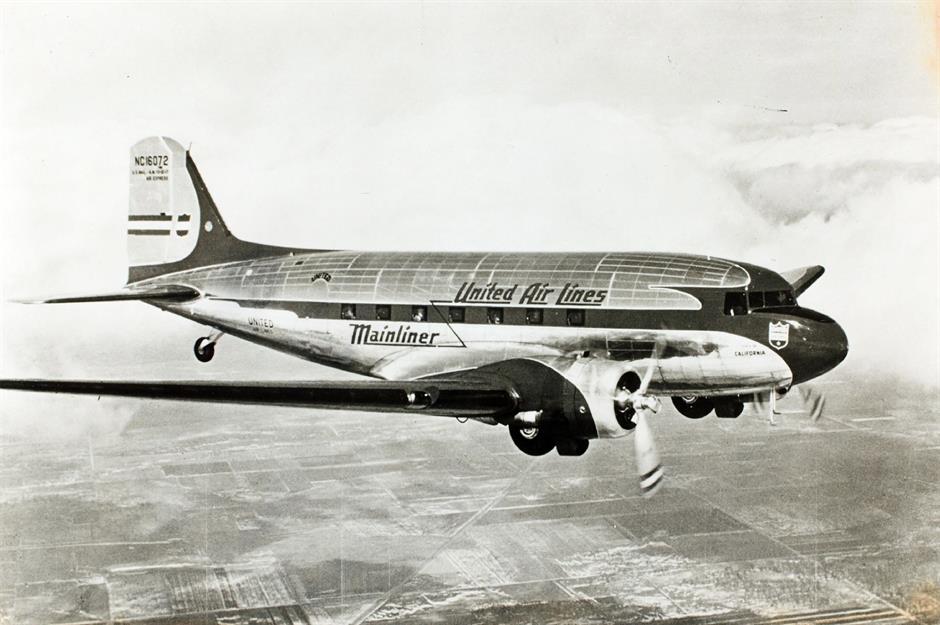
1930s: Pan American Airways flies across the Atlantic in 1939
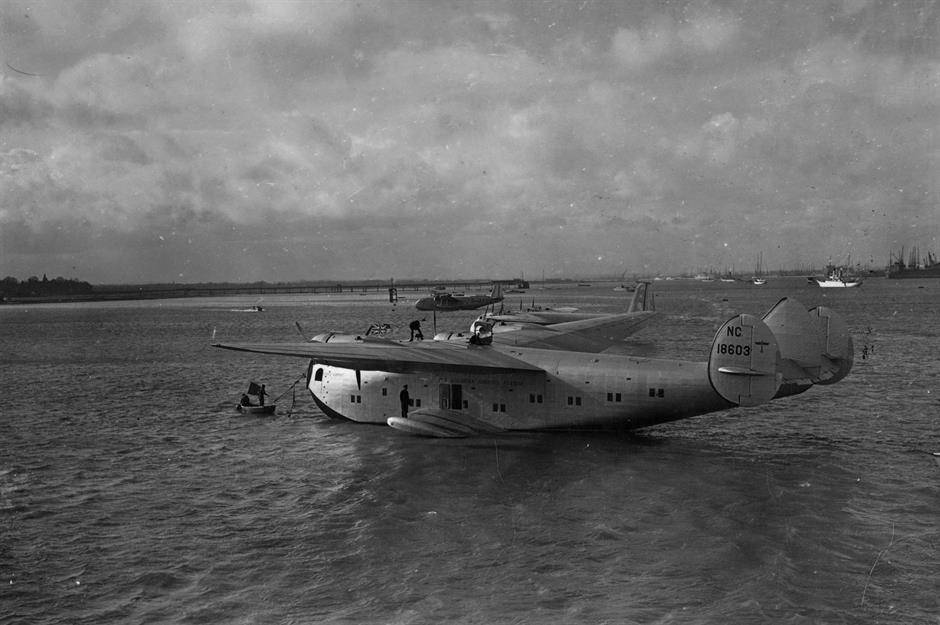
The 1930s also saw some of the earliest commercial flights across the Atlantic. Pan American Airways was one of the forerunners, transporting passengers over the Atlantic by 1939. The Yankee Clipper aircraft or 'flying boat', which was used to undertake this journey, is pictured here in Calshot, Southampton, UK after a flight.
1940s: Pan American World Airways' 'Flying Cloud' clipper
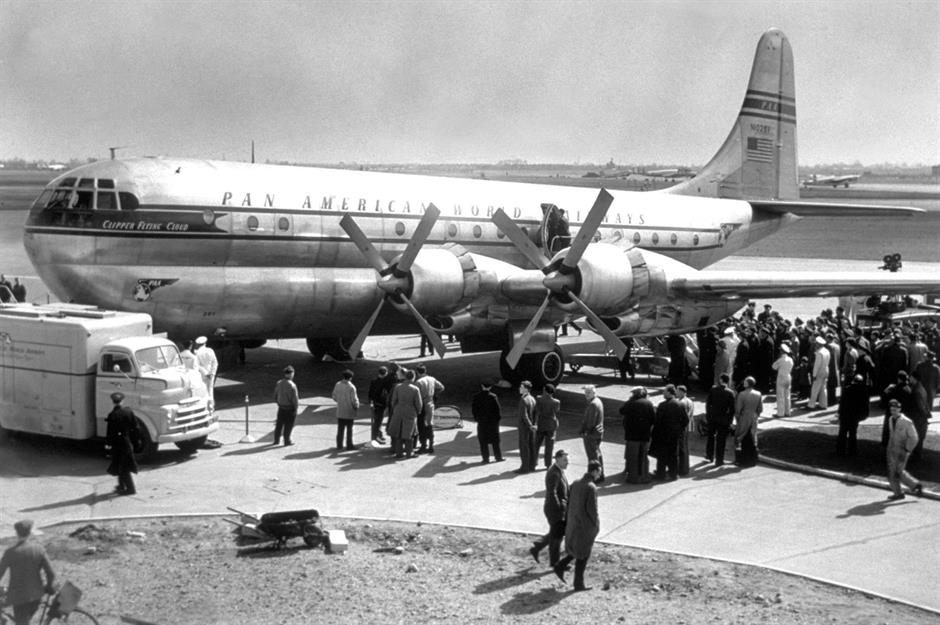
The onset of the Second World War meant developments in commercial aviation were put on the back burner, and all resources were plunged into the war effort. However, by the end of the decade, the industry was recovering, especially since the war had given rise to new runways and military aircraft were able to be converted and put to commercial use. This 1949 shot shows Pan Am's 'Flying Cloud' clipper, the first of a group of planes to begin a service between New York and London in the 1940s.
1940s: passengers aboard a Pan Am Boeing 307 aircraft circa 1945
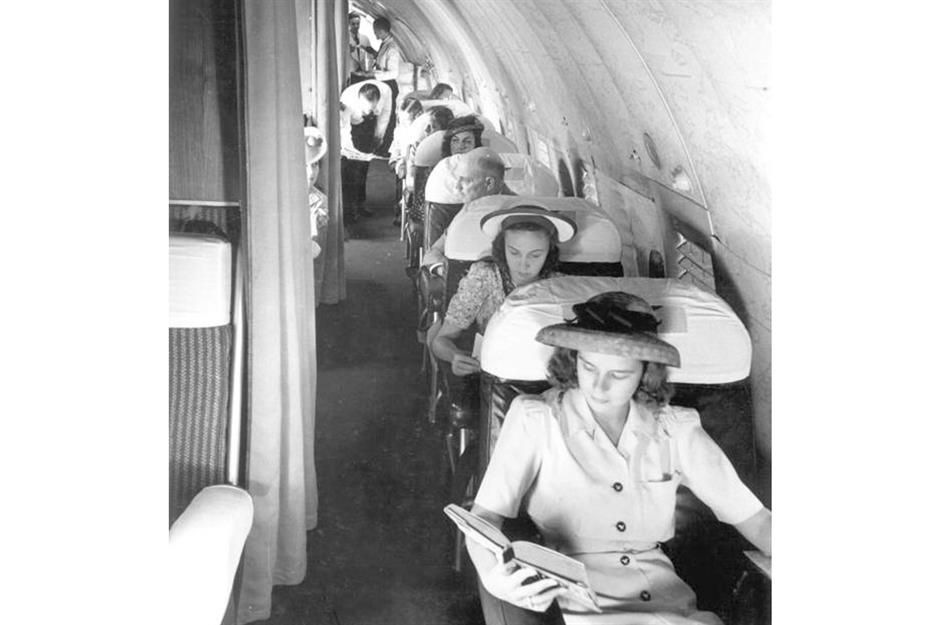
Pan Am began operating its fleet of Boeing 307 aircraft in the 1940s. The Boeing 307 was another model that propelled commercial aviation forwards, since it was the first to boast a pressurised cabin. This meant passengers (as pictured onboard here circa 1945) could enjoy a comfortable ride at around 20,000 feet (6,096m). The model was also flown by TWA.
1940s: posters advertising TWA
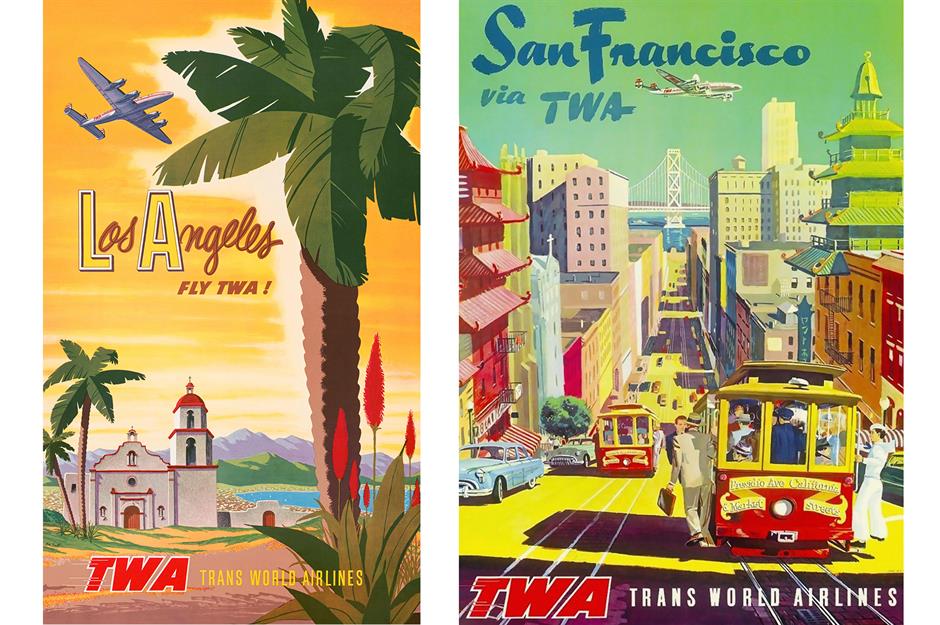
As competition grew towards the end of the decade, major airlines increased their advertising efforts – as seen in these TWA posters from the 1940s, showcasing the airline's fleet of advanced Lockheed aircraft, including the L-049 Constellation, which entered service in 1945. This period set the stage for the so-called 'golden age of travel,' with innovations in aviation paving the way for more comfortable and efficient air travel in the coming decades.
1950s: crowds wave off the world's first jet airliner service
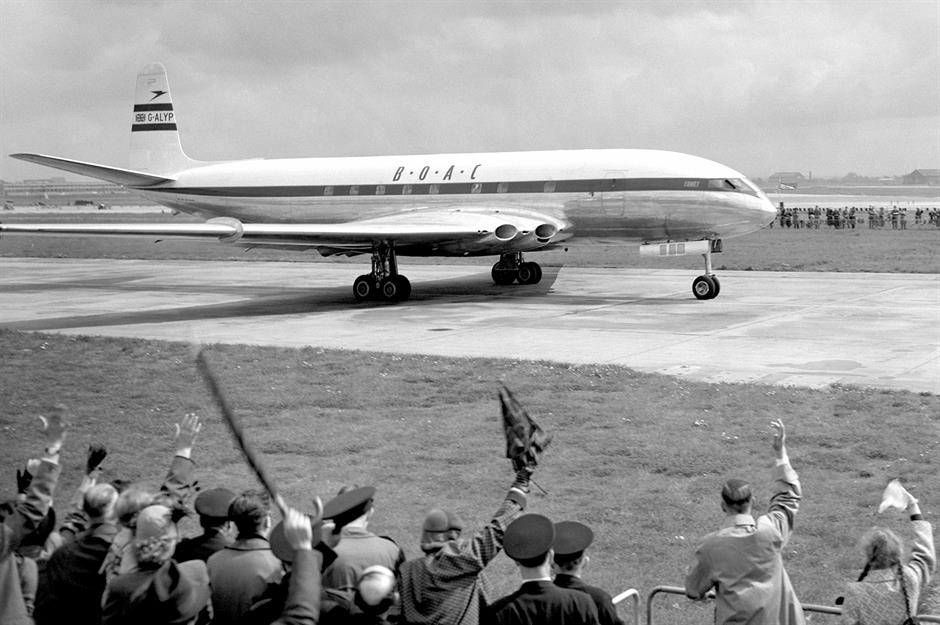
Commercial air travel boomed through the 1950s and, for the first time in history, more US passengers were travelling by air than train. The 1950s also ushered in the 'jet age'. The de Havilland DH 106 Comet became the world's first commercial jet airliner, debuting in 1952 with the British Overseas Airways Corporation (BOAC). Here, crowds are seen waving the aircraft off as it leaves London for Johannesburg, South Africa.
1950s: making the world smaller

The de Havilland DH 106 Comet jet airliner was much faster than earlier piston aircraft, slicing hours off journey times and making the world smaller still. The model could hold 36 passengers, with airline staff treating them to tasty slap-up meals with wine while onboard. Here we see the first de Havilland DH-106 Comet 4 flown by test pilot John Cunningham. According to Cunningham, the plane performed very well during the test. However, patrons' confidence in the aircraft model plummeted in the coming years as it suffered a series of crashes.
1950s: a test flight for the Boeing 707 jet airliner with Pan Am

The jet age was not over yet though. The Boeing 707 jet airliner, which was introduced later in the decade, was larger and even more economical than its predecessor, and would enjoy much more commercial success. Pan American Airways began a regular service with this aircraft in 1958 and the model would remain in civil operation right up until 2019. This photograph shows crew embarking on a test flight with Pan Am back in 1958.
1950s: the Queen arrives in Bermuda on a BOAC flight in 1953
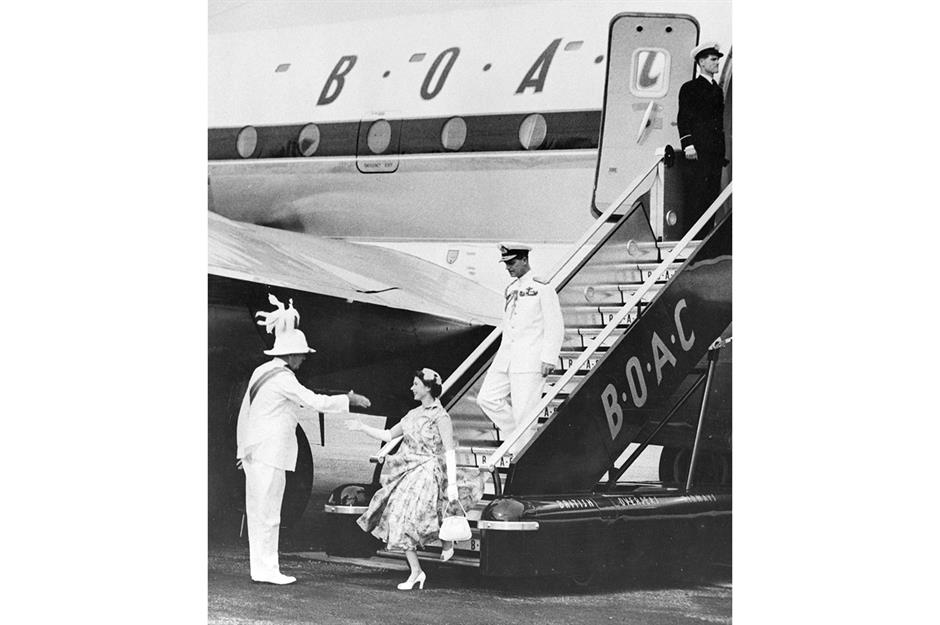
Though commercial aviation was developing at an alarming rate, it hadn't quite opened up to the masses yet. In this decade, plane tickets were still very expensive, so air travel was the domain of the wealthy and elite. Fit for royalty, this BOAC flight landed Her Majesty the Queen safely in Bermuda in 1953: she visited the country just months after her coronation.
1950s: an air hostess attends to passengers on a National Airways Corporation flight in 1959
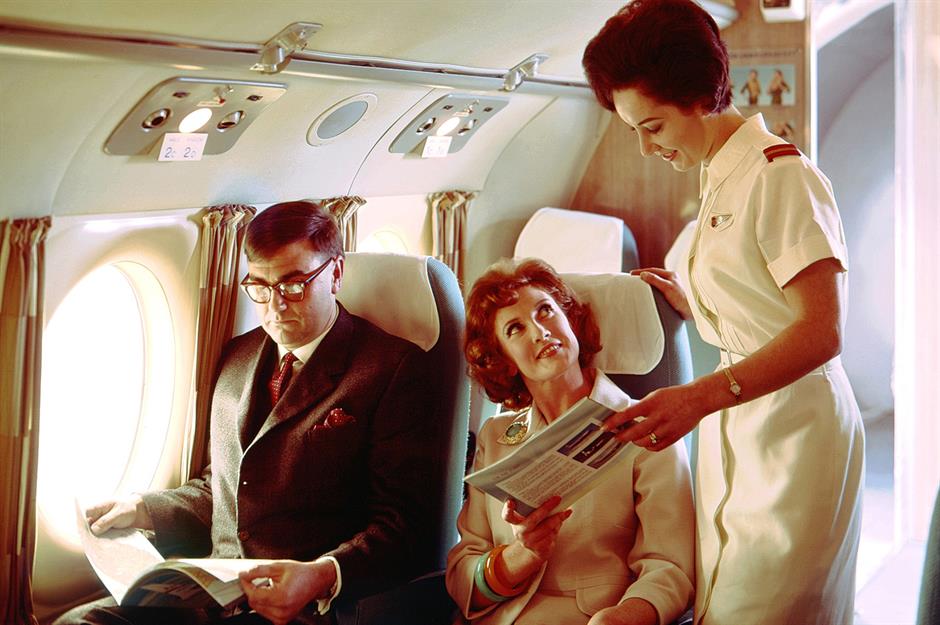
Without the hi-tech entertainment systems of the modern day, passengers were forced to find other ways to occupy themselves on a long flight. Flying was still a real novelty, so air stewards would often hand out postcards for passengers to document their on-board experience. Travellers would spend their flight scribbling details about their time in the air, from the fine food to the free-flowing booze.
1950s: a movie projector on a United Airlines flight circa 1950
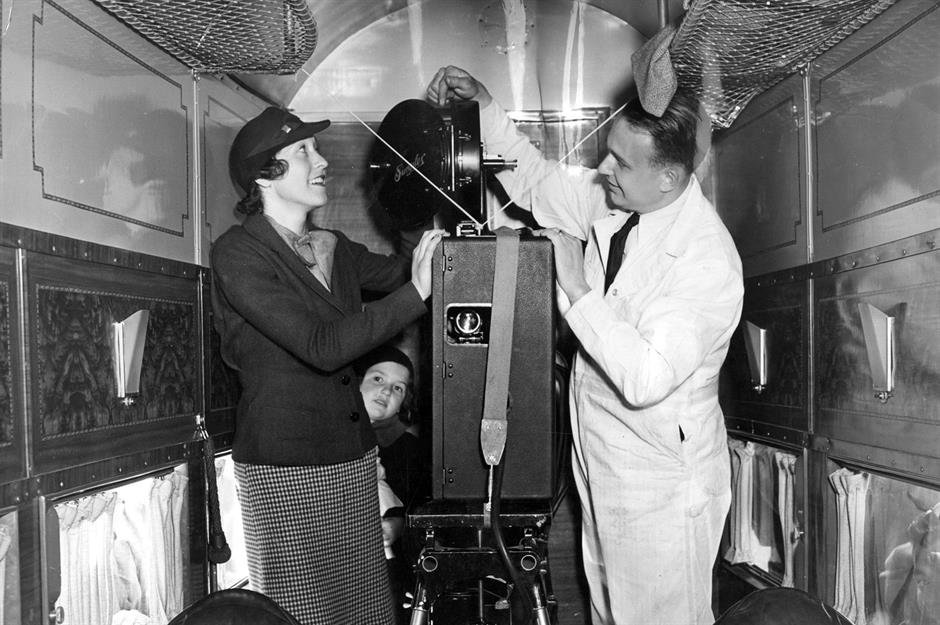
The concept of the in-flight movie, though gaining popularity, was still not commonplace across all aircraft, and it wouldn't truly take off until the 1960s. Before this, it wasn't completely unheard of for passengers to enjoy live performances from singers and musicians. Otherwise, they'd content themselves with reading and mingling with fellow passengers and crew.
1960s: lunch service on an SAS flight in 1960
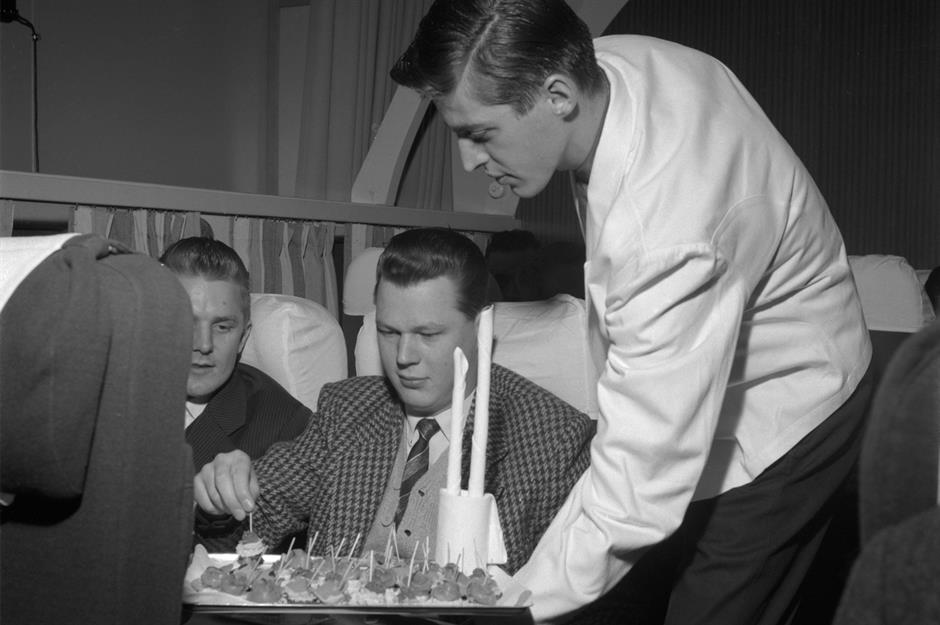
The golden age of travel reigned on through the 1960s and, partly since there wasn't much else to do, dinner was a grand affair. Menus often included multiple courses, bread baskets and dishes such as steak or even lobster. In this snap, taken at the start of the decade, passengers are being served tasty-looking snacks onboard a flight operated by Scandinavian Airlines System (SAS).
1960s: dinner aboard a SAS aircraft in 1969
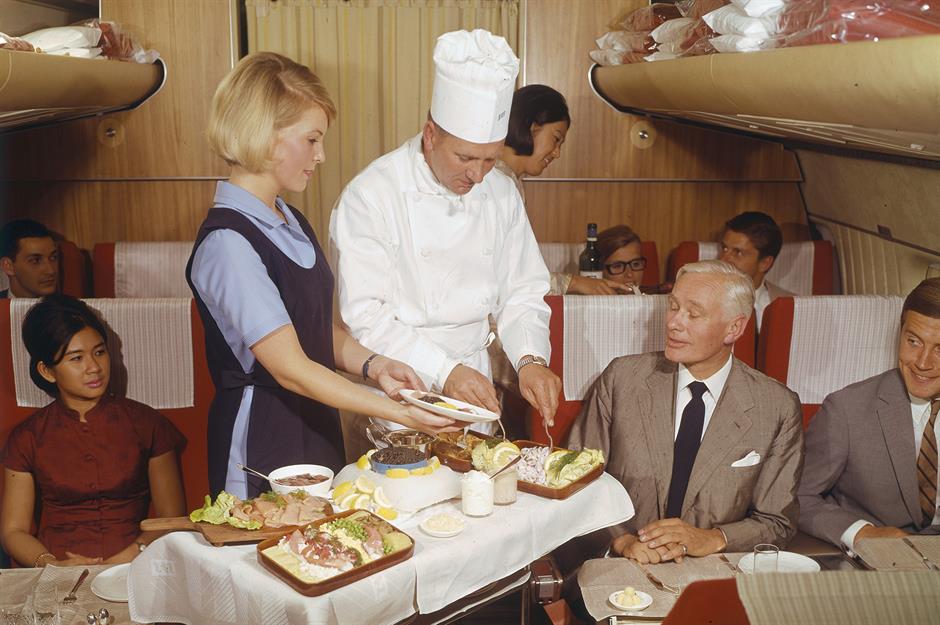
Passengers are receiving similar treatment on this SAS flight in 1969. In this instance, the chef has even come to serve and greet first-class travellers. Flying was such an important occasion that it was common for passengers to come aboard in their finest clothes, with women in dresses and men opting for tailored suits.
1960s: The Beatles arrive in London on a Pan Am flight in 1964
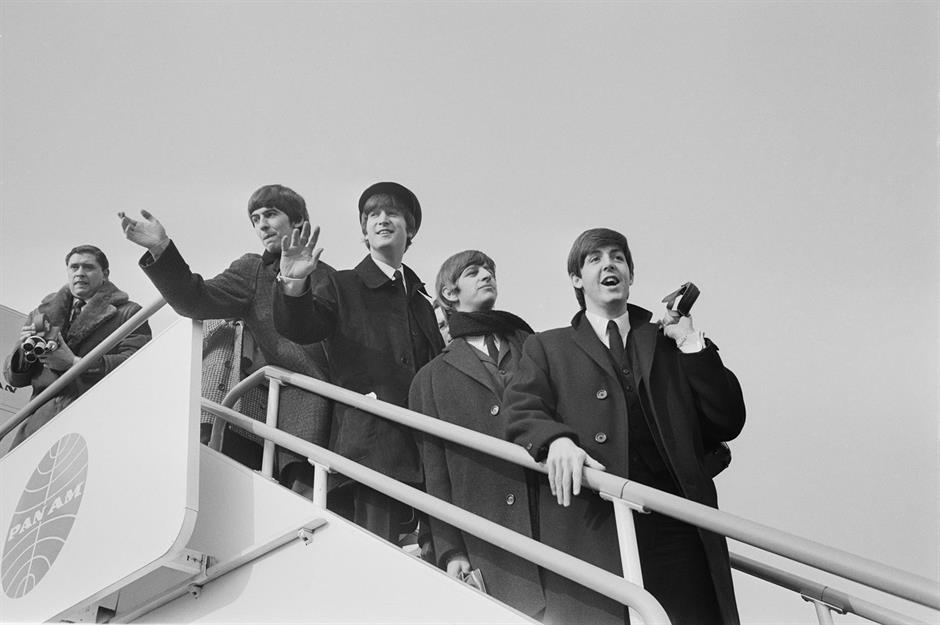
The term 'jet set' was coined to refer to those who were privileged enough to travel on these new commercial jet airliners. Among the regular passengers were the biggest celebrities of the day. Here, The Beatles are pictured in their heyday, leaving a Pan Am flight in London in 1964.
1960s: flight attendants line up before a model of Concorde in the 1960s
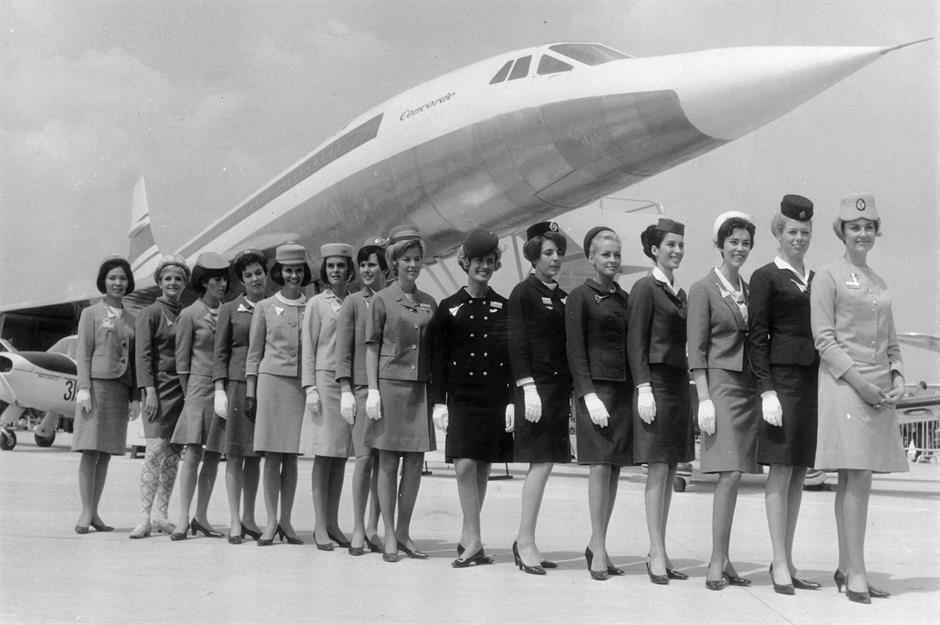
In the 1960s, development on what would become one of the most iconic aircraft in commercial aviation began. The project had been floated since the 1950s, and the aim was to create a supersonic airliner that would revolutionise commercial aviation. Concorde made its maiden test flight in 1969 and here flight attendants from various airlines stand before a full-scale model of the aircraft.
1970s: the first Concorde flight from London Heathrow to Bahrain in 1976
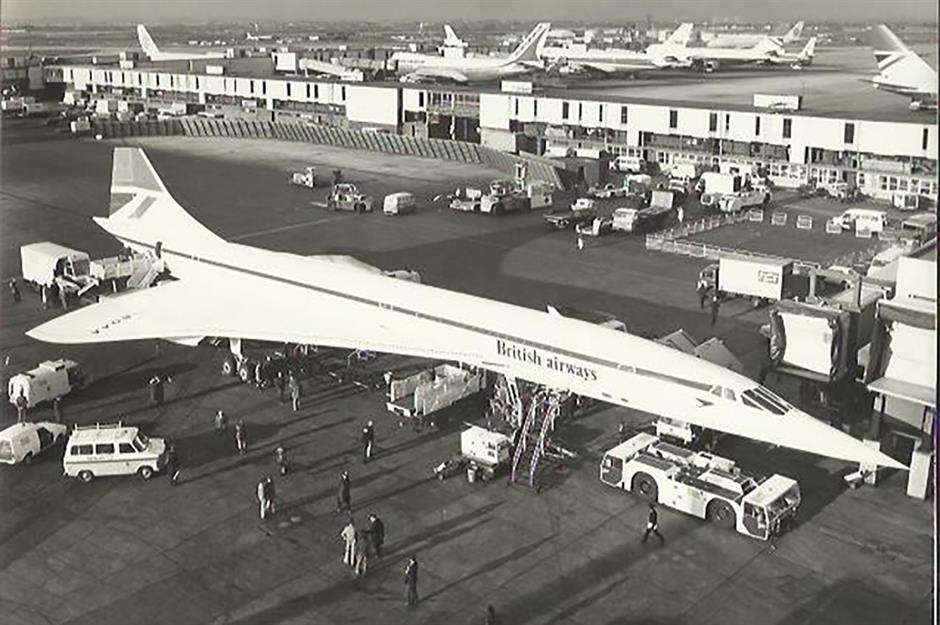
Though many airlines initially showed interest in Concorde, numerous orders were dropped after concerns were raised as to the aircraft's noise, environmental impact and economic potential. In the end, only Air France and BOAC would operate Concorde. The airliner is pictured here at London Heathrow in 1976 as it begins service with a BOAC flight from the UK to Bahrain.
1970s: the Queen on a Concorde aircraft in 1977
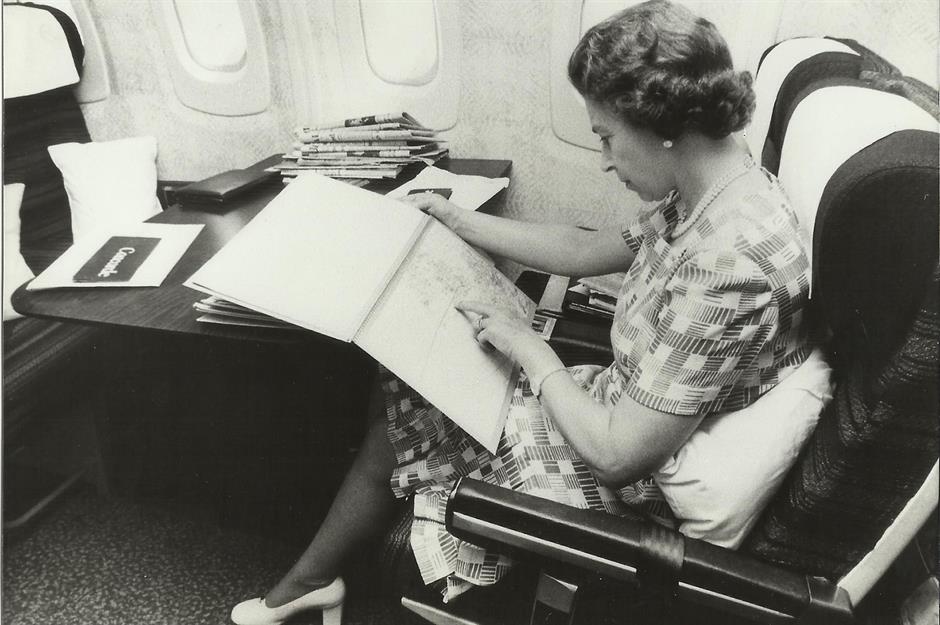
Concorde got the royal seal of approval (the Queen is pictured here onboard a Concorde aircraft in 1977), with its ability to cross the Atlantic in just 3.5 hours. But only a privileged few could afford to ride aboard the Concorde and it ultimately didn't shake up commercial air travel in the way it had been hoped. Cancelled routes, economic setbacks and a devastating crash meant the Concorde was out of service by 2003.
1970s: Laker Airways founder Freddie Laker celebrates the airline's success
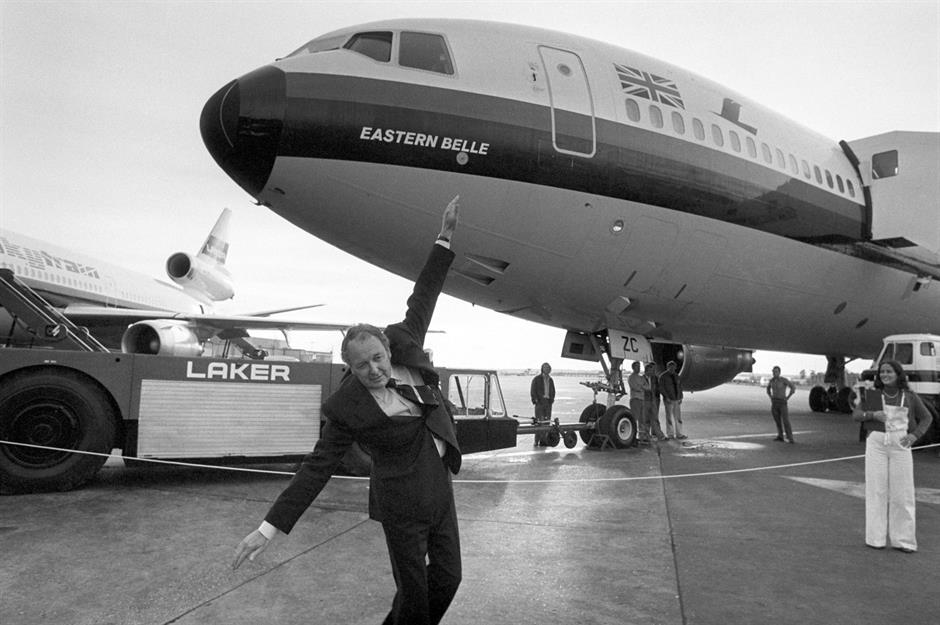
Another major player in the 1970s was Laker Airways, which was actually founded in 1966. While Laker began as a charter service, in the 1970s it would become an early 'no frills' airline, a predecessor of today's budget airlines. Pictured here is Laker's jubilant founder Freddie Laker, celebrating the inaugural flight of the Skytrain at Gatwick Airport in 1977 by impersonating a plane.
1970s: Laker and passengers aboard Laker Airways' Skytrain
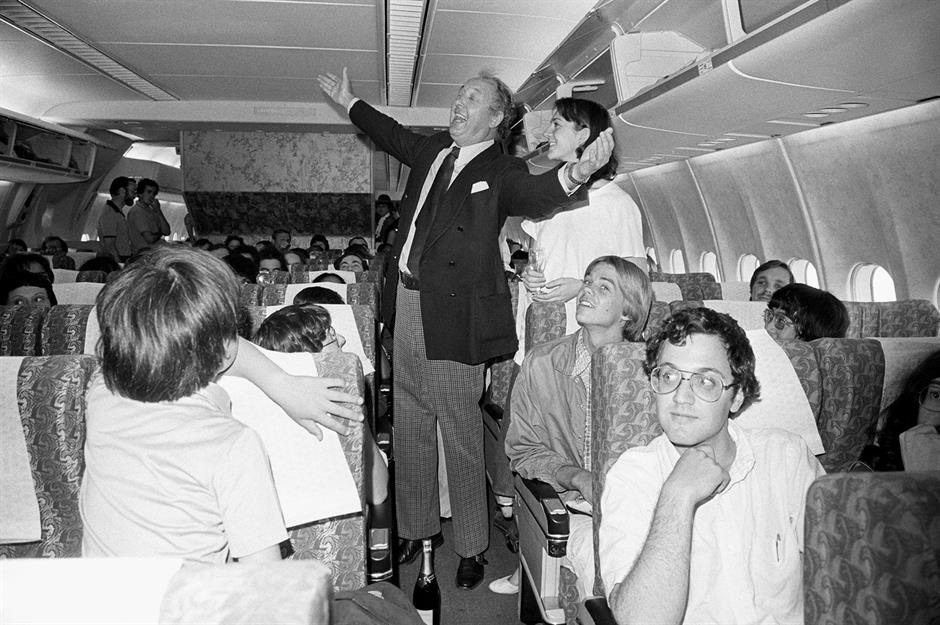
Laker Airways' Skytrain offered a lower fare service between London Gatwick and New York's JFK, which began on 26 September 1977. Like many budget airlines today, the 'no frills' service meant passengers had to purchase meals onboard and weren't subject to the usual luxuries of air travel in the era. Laker also came up with ways to reduce fuel consumption and engine wear to enable the lower costs. He's pictured here celebrating with passengers aboard the Skytrain in 1979.
1970s: the first scheduled Pan Am Boeing 747 flight
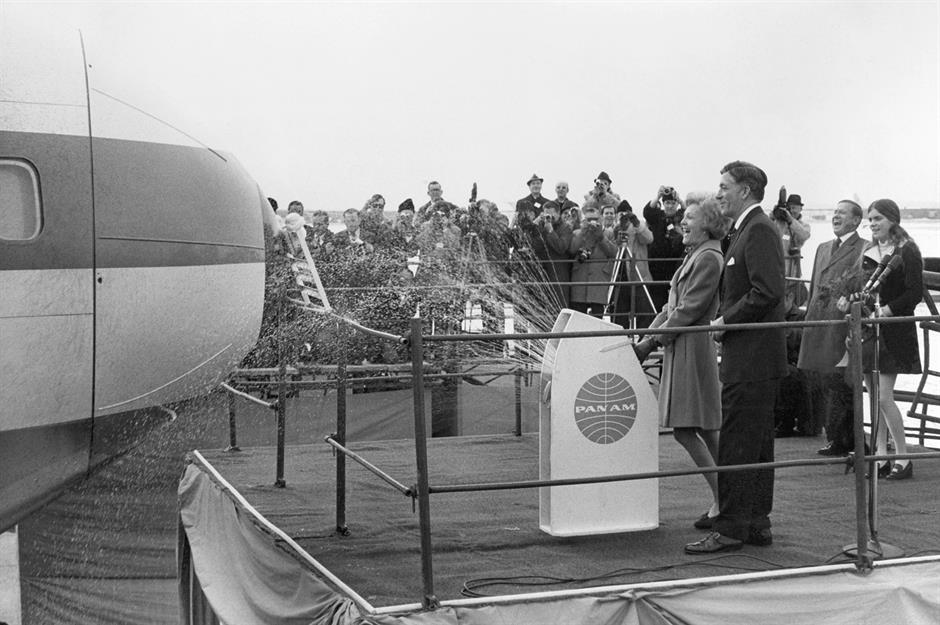
Another major leap for commercial air travel in this decade came with the introduction of the Boeing 747, a wide-bodied jet aircraft able to carry many more passengers than its predecessors. Here, the American First Lady Patricia Nixon sprays Champagne onto the aircraft ahead of its maiden commercial flight from New York to London, in service with Pan Am in January 1970.
1970s: passengers in the cabin of a Boeing 747
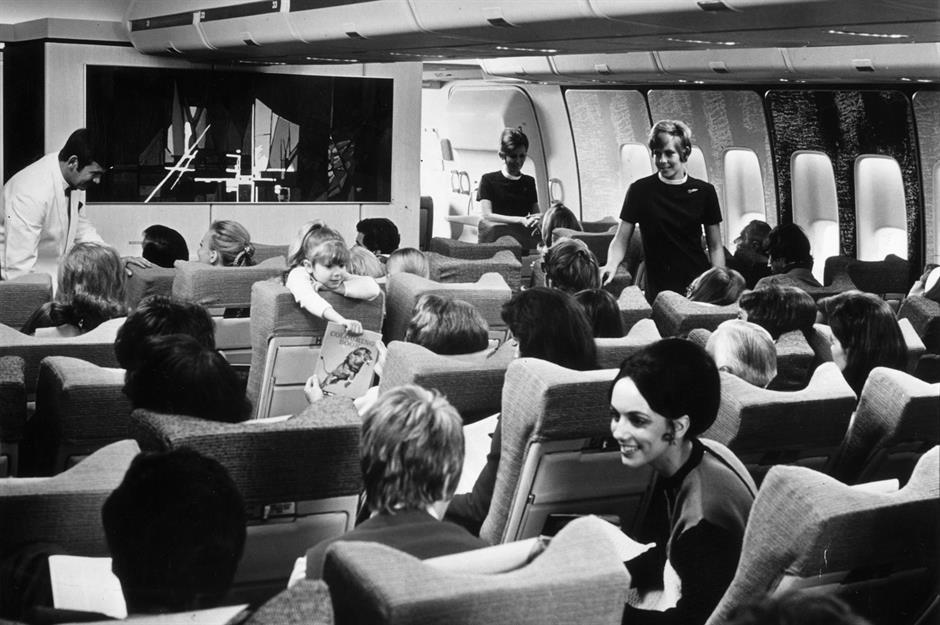
This was the first time that air travel was truly opening up to the masses. Since planes were larger, airlines were able to hold more passengers and therefore sell more tickets at a reduced price. Though flying still wasn't cheap, it was no longer only reserved for the super-rich. This 1970s shot shows the spacious cabin of a BOAC Boeing 747, filled with families, couples and other holidaymakers.
See what family holidays looked like the decade you were born
1970s: lunch is prepared on a Swedish passenger plane
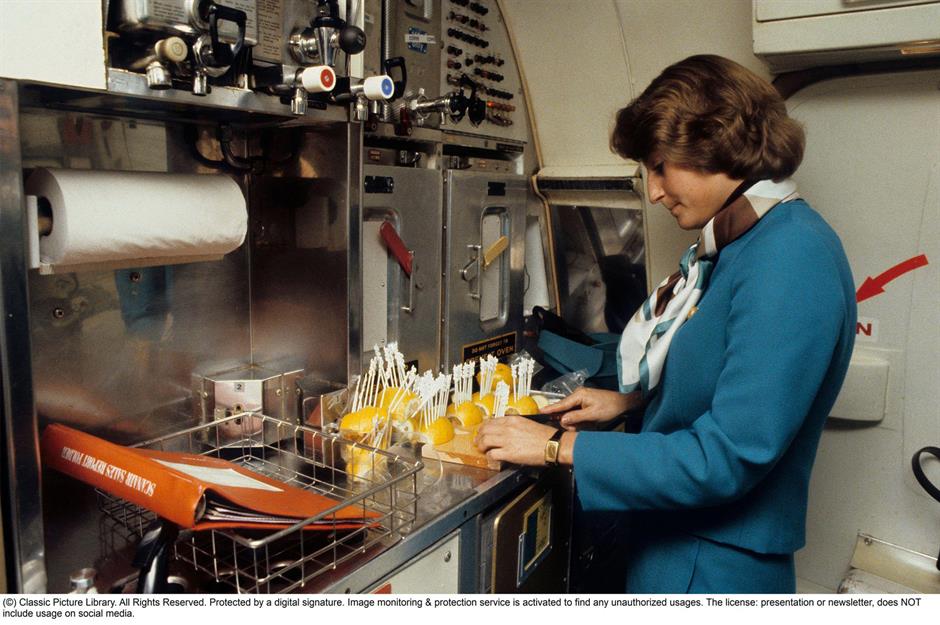
The long and lavish onboard lunches that characterised the 'golden age of travel' weren't lost in the first-class cabin in the 1970s either. In this shot, taken in 1979, a flight attendant working for Swedish airline SAS can be seen meticulously preparing some drinks.
1970s: passengers are served coffee in china teacups on a Pan Am 747 flight
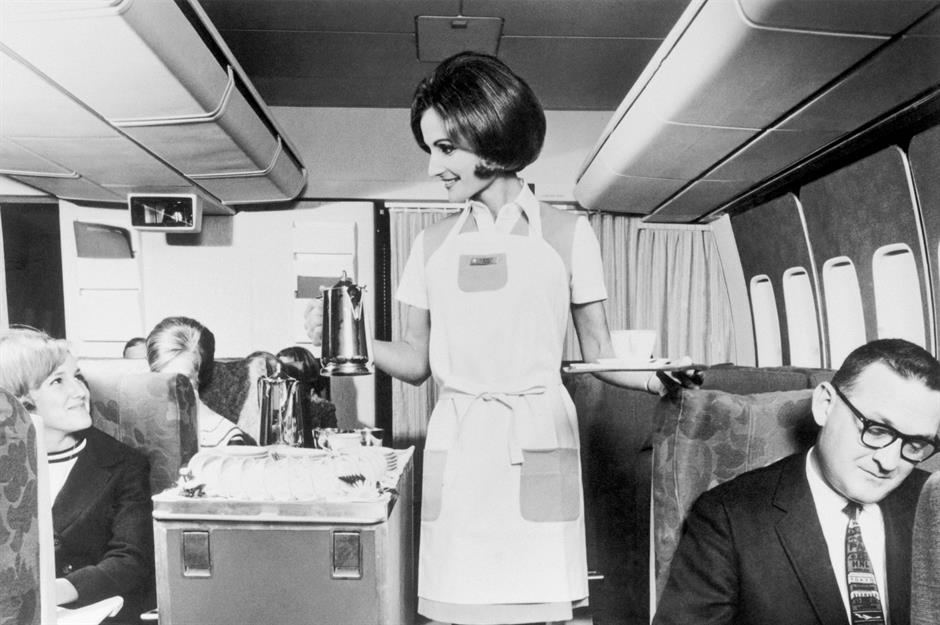
Those passengers who could afford it needn't have skimped on luxury, though. Here, passengers onboard a Pan Am 747 can be seen having their coffee served in china crockery (a world away from the cardboard cups of today). In the 1970s, travellers in first class were treated to Champagne.
1970s: a lounge on SAS's Boeing 747-B "Huge Viking"
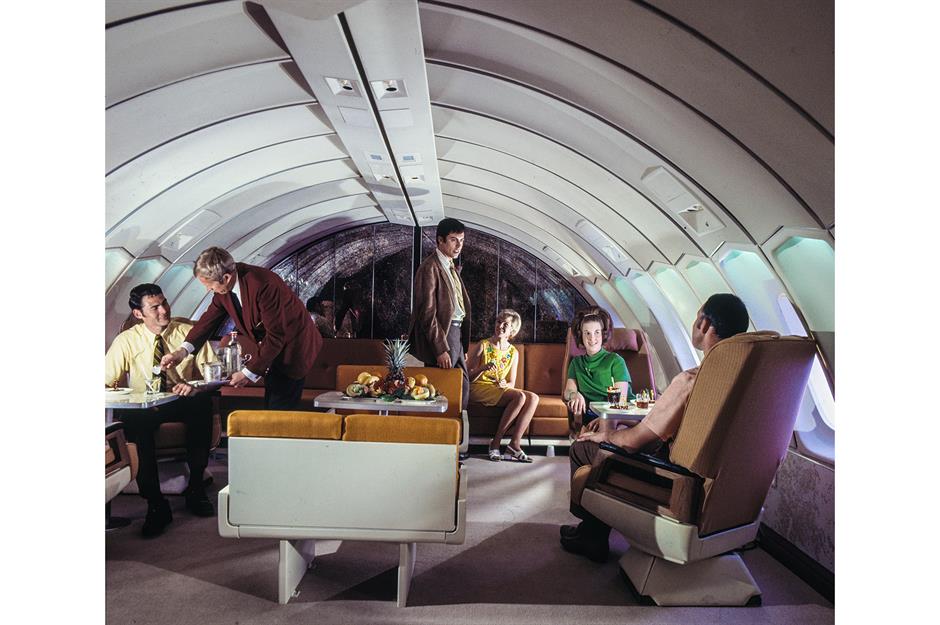
Swish onboard lounges were still commonplace for first-class guests too and most travellers would socialise with their fellow passengers over drinks. This lounge was onboard SAS's Boeing 747-B (nicknamed the 'Huge Viking') in the 1970s.
1980s: Laker celebrates further fare cuts in 1980
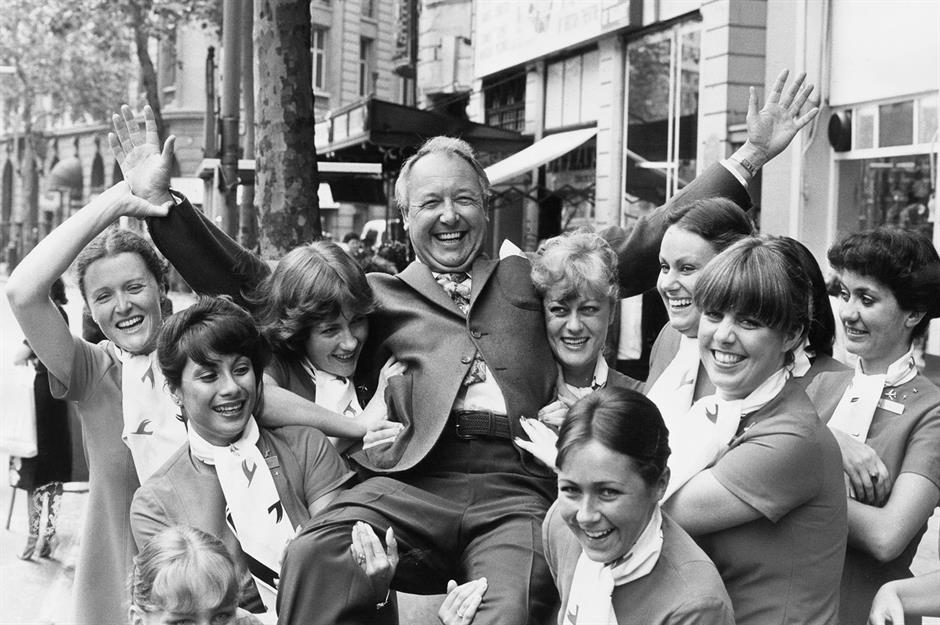
The 1980s arrived and it wasn't kind to all commercial airlines. In this photo, at the turn of the decade, Laker can be seen celebrating further cuts to the fares of his transatlantic Skytrain service. However, there wasn't cause for celebration for long, since Pan Am also dropped the cost of its transatlantic journeys to compete. The recession of the early 1980s hit Laker hard too.
1980s: passengers are stranded as Laker Airways collapses in 1982
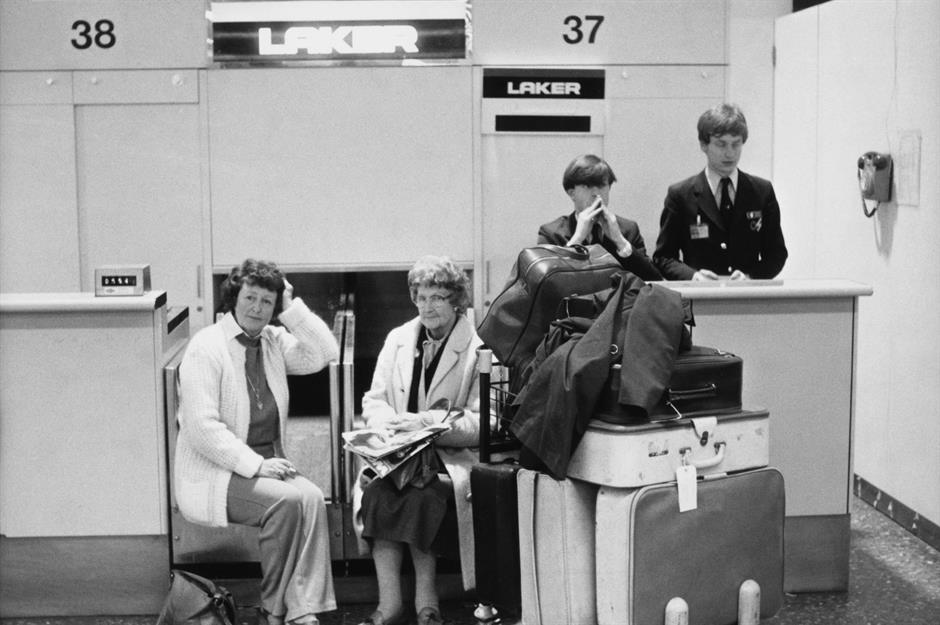
Laker Airways collapsed in 1982, saddling debts amounting to £270 million ($374m). More than 6,000 passengers were left stranded in airports around the world. Here, exasperated travellers and dismayed Laker staff feel the brunt of the collapse on 5 February 1982.
1980s: a Ryanair aircraft in 1988
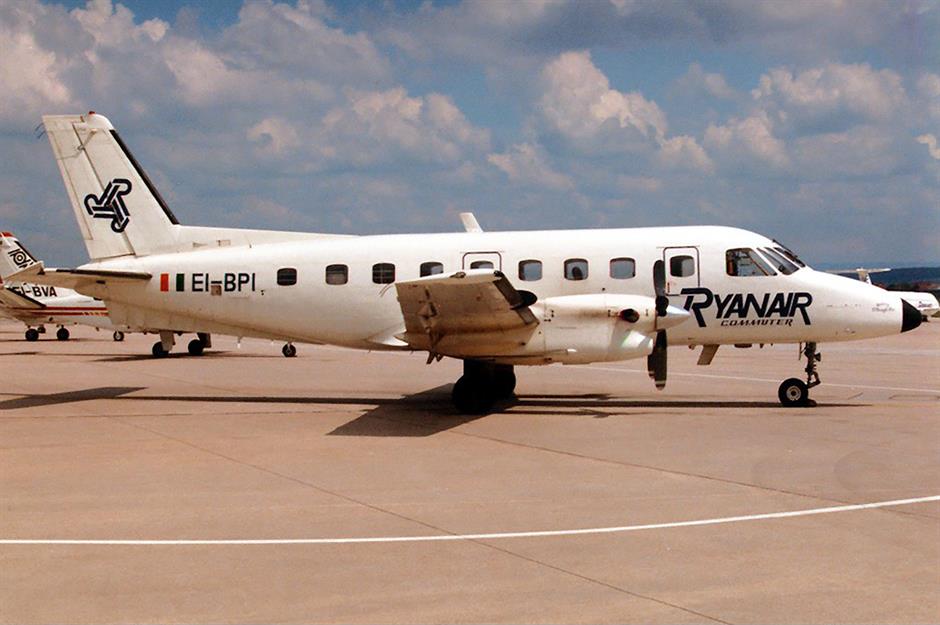
The fate of Laker Airways didn't stop the rise of other low-cost carriers though, and Ryanair launched in 1985. Early services covered short distances, with the first flights operating from Ireland's Waterford to London Gatwick. Ryanair set the bar for today's budget airlines and it's now one of Europe's largest carriers. A branded aircraft is pictured here at Stuttgart Airport in 1988.
1980s: Richard Branson celebrates the launch of his new airline, Virgin Atlantic Airways, in 1984
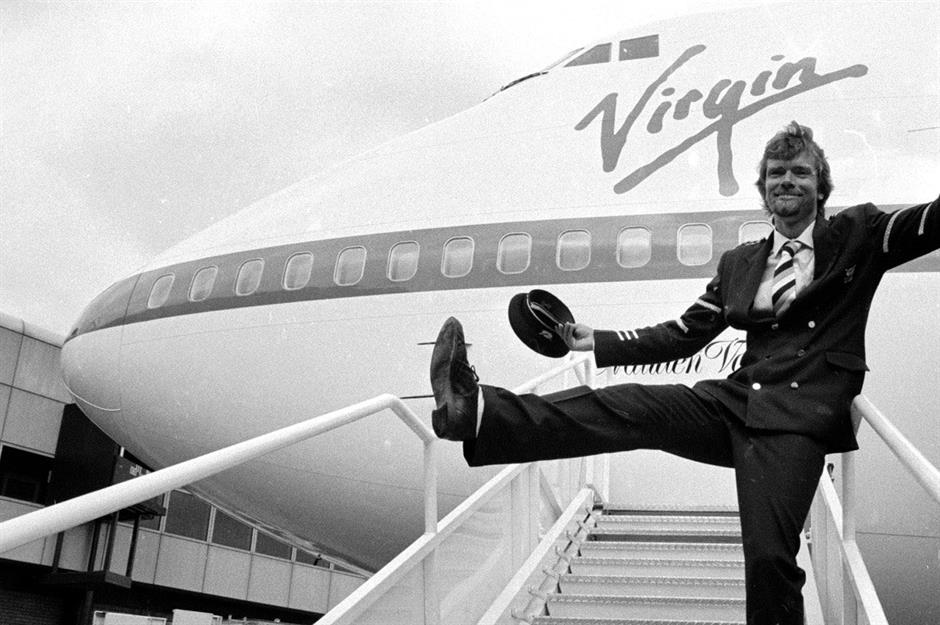
Balancing out the rise of the low-cost carrier, Virgin Atlantic Airways was also launched in this decade. Branson's mission was to pay homage to the golden era of travel by elevating the experience of flying once more, offering passengers a luxurious but not unattainable journey. On 22 June 1984, Branson celebrates the launch of his new airline.
1980s: a flight attendant serves dinner on a SAS flight circa 1980s
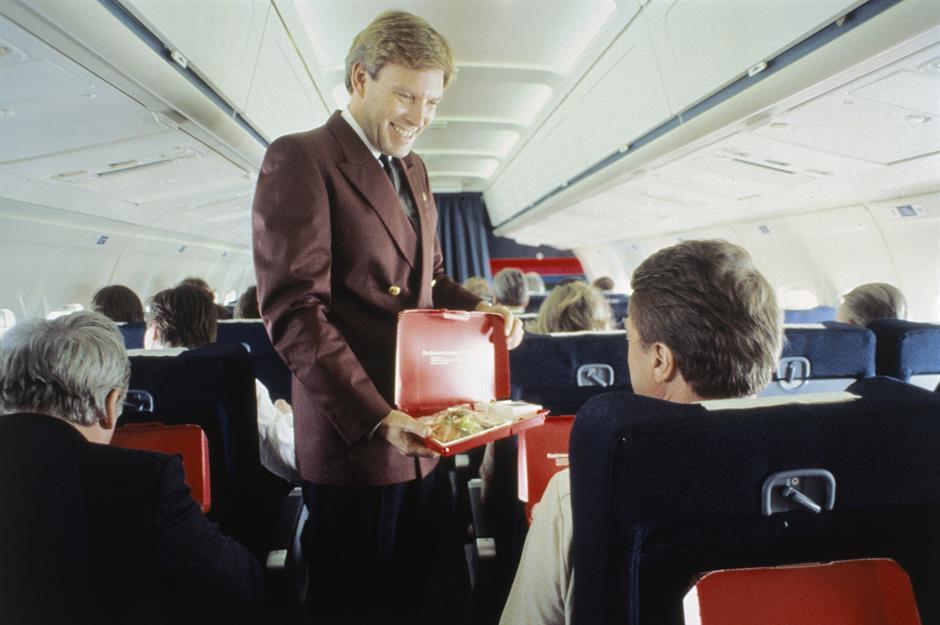
Through this decade, as flying became more and more commonplace, the economy class cabin looked much as it does today. Lavish, multi-course meals had been mostly replaced with more humble dinners served from boxes or trays. This photo shows a SAS flight attendant serving boxed meals to passengers.
1980s: ashtrays on a commercial flight
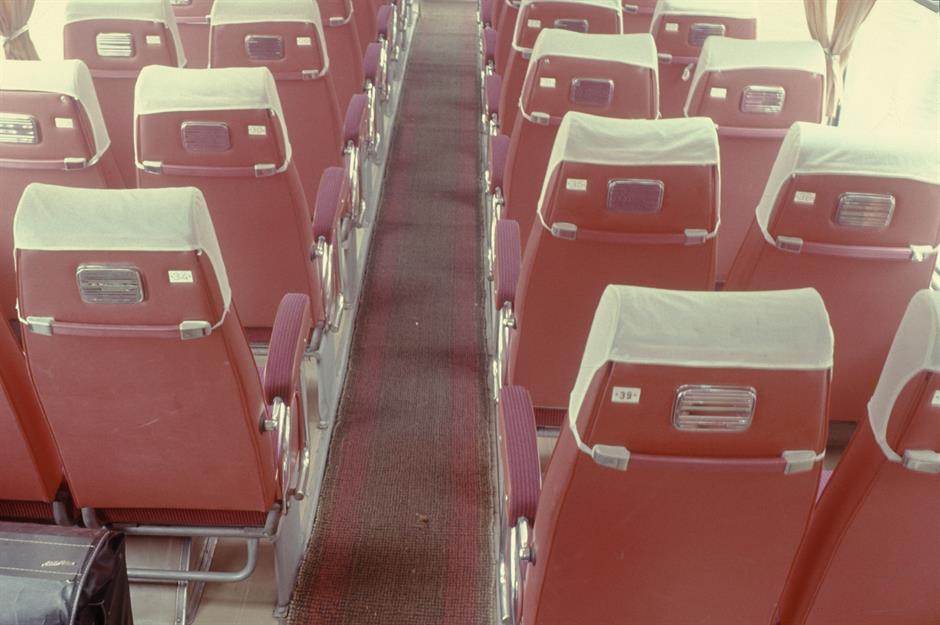
Another major change came in 1988 when, for the first time, smoking was prohibited on US domestic flights of less than two hours. Just a year later, the law was extended to flights of six hours, which applied to almost every flight across the country. This smoking ban wasn't adopted internationally until 2000.
1990s: easyJet boss Stelios Haji-Ioannou in 1995
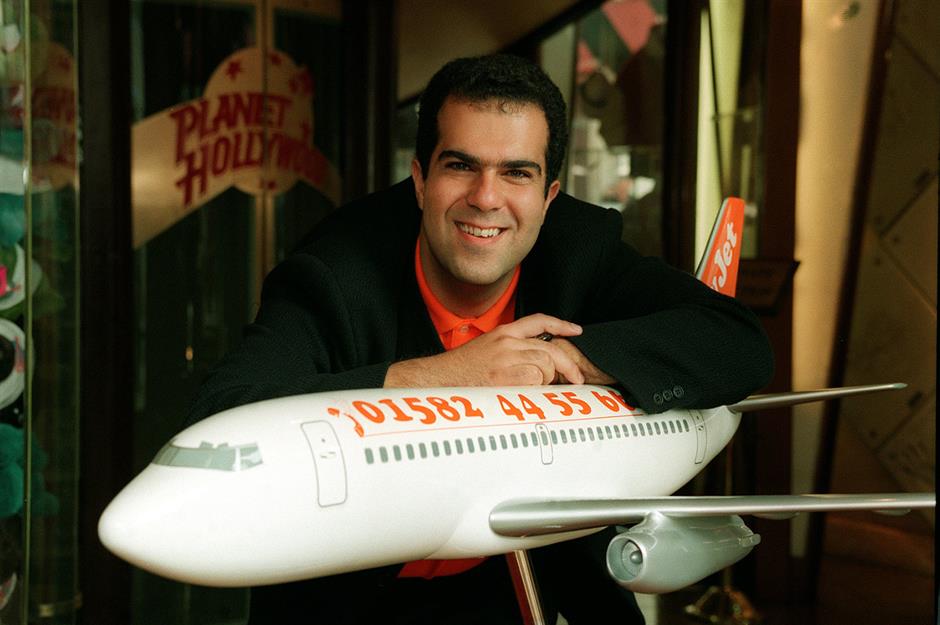
1990s: Ryanair's chief executive promotes low-fare flights
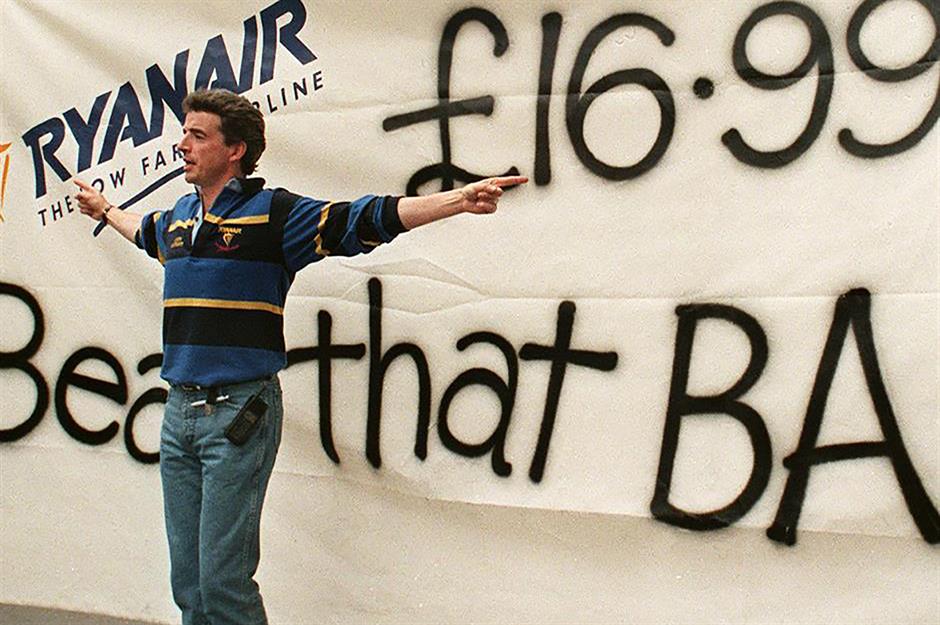
The introduction of Ryanair and easyJet (and also Norwegian in 1993) meant pressure was put on traditional carriers, fares were pushed down and air travel became increasingly more accessible. As travellers also began booking holidays online, competitive pricing became more important than ever.
1990s: a Pan Am aircraft in 1991
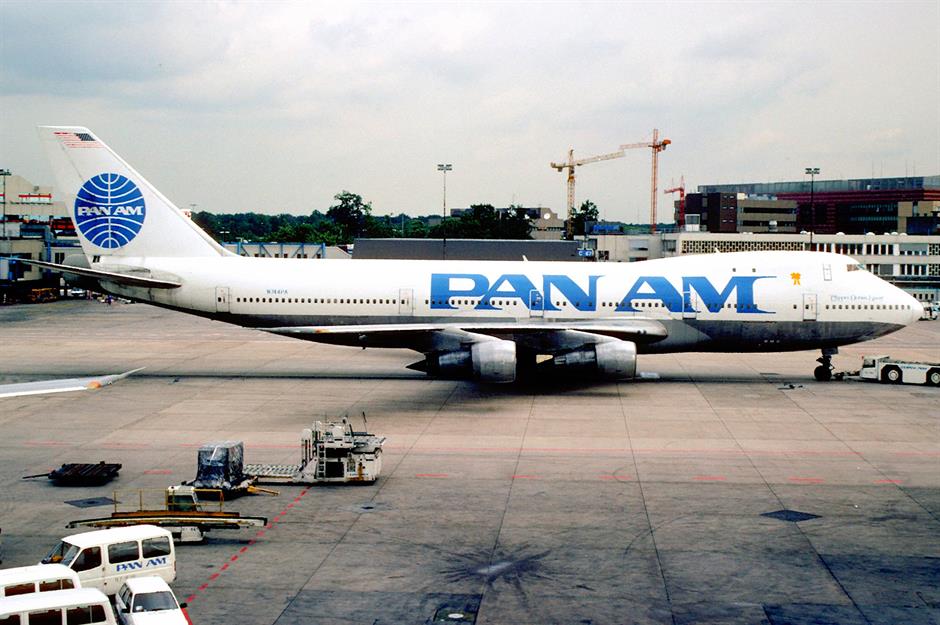
2000s: security at Salt Lake City International Airport in 2001
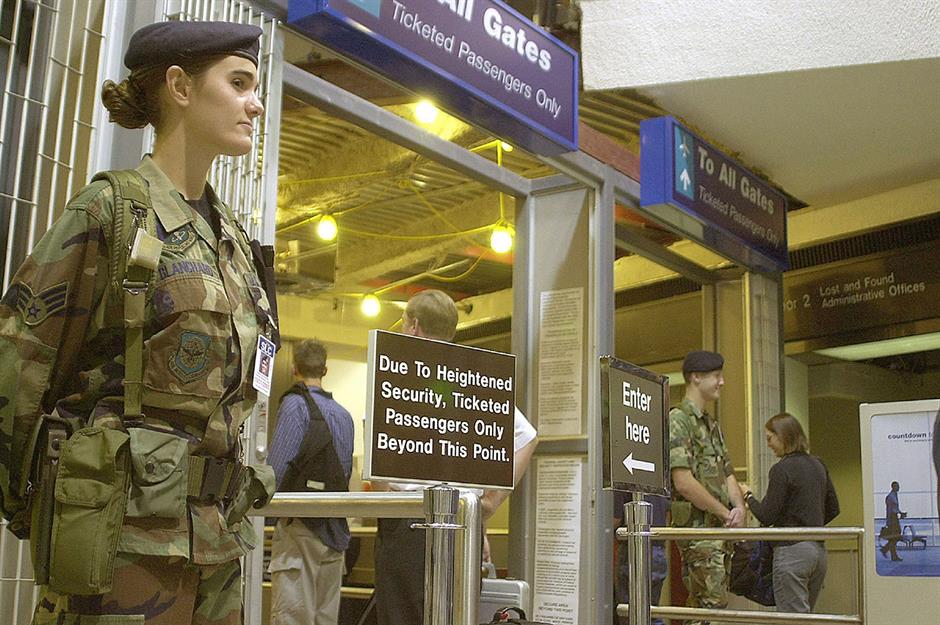
2000s: the door to an aircraft cockpit in 2001
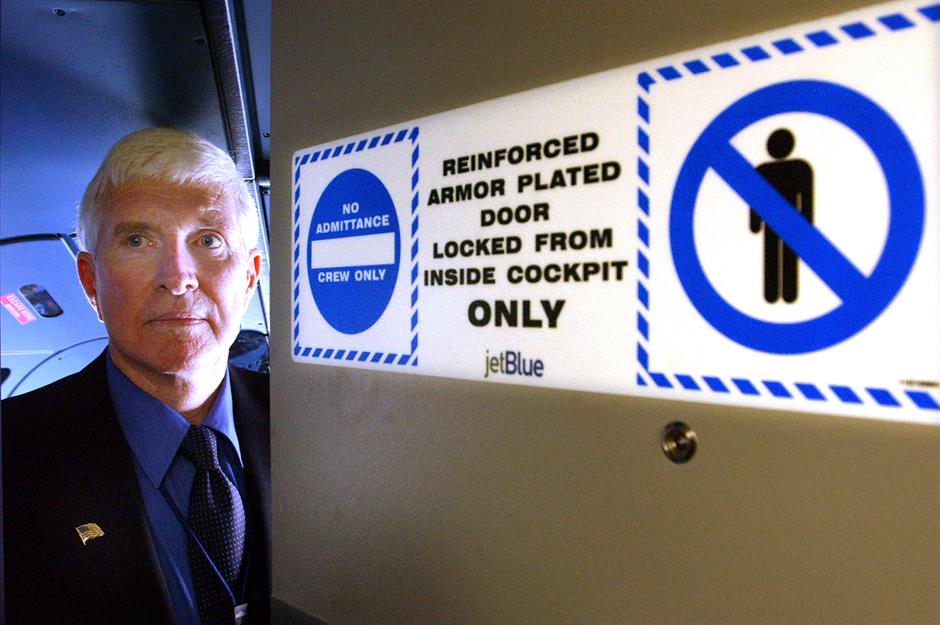
2000s: an easyJet aircraft flying in 2009
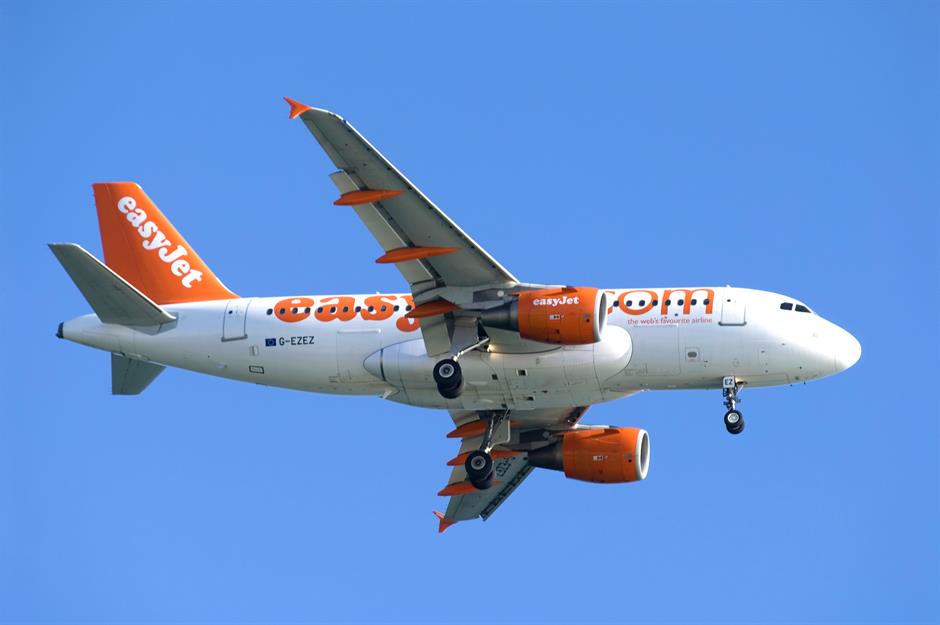
Travellers eschewed air travel in the years following 9/11 and, according to the Bureau of Transportation Statistics, it took until 2004 for air-passenger numbers to reach their pre-9/11 peak. Commercial air travel was recovering by the end of the decade, though, with US air passengers numbering 769.6 million in 2007 – a record high. During this time, it was low-cost carriers that saw the most growth.
2000s: a traveller books flights online
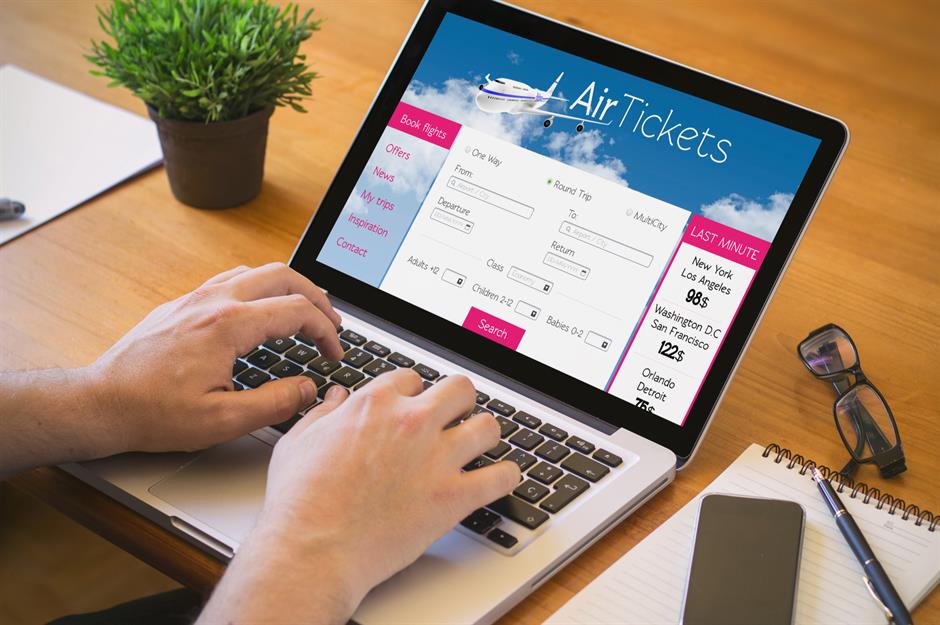
Another significant change during this decade was the way travellers were choosing to book their flights. According to PhoCusWright, a tourism research company, 2009 was the first year that more than half of all travel-related bookings were made online. This placed even more pressure on airlines to be competitive and offer the best value for money.
2010s: a man works on his laptop during a flight
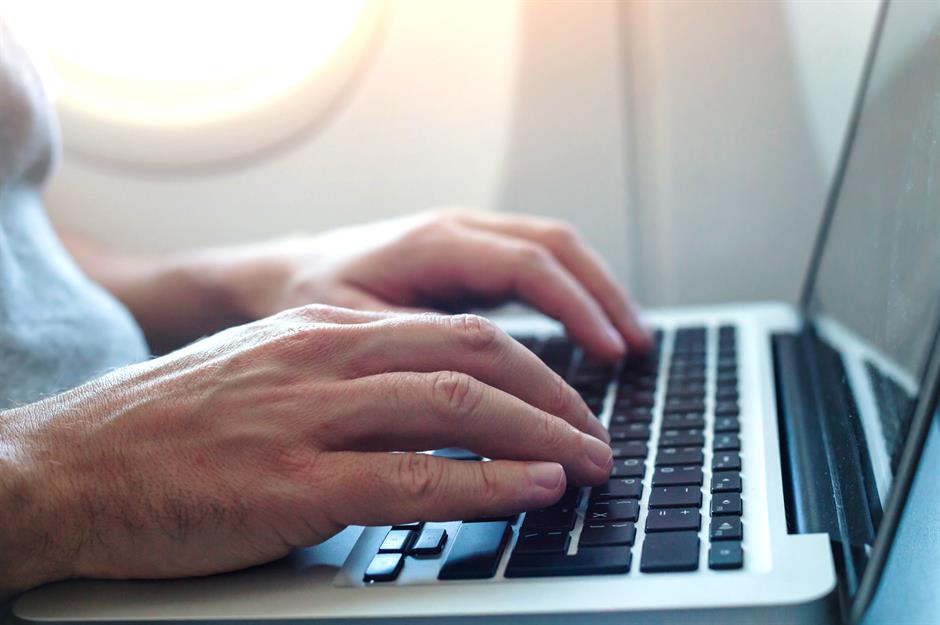
The internet hasn't just infiltrated the booking process. Nowadays it's commonplace for carriers to offer in-flight wifi, either as part of the package, or for an extra premium. In a major shift from the golden age of travel, this means that flying today is no longer just about pleasure and relaxation – it's also about catching up with work and keeping in touch with people on the ground. Online check-in and smartphone boarding passes have also revolutionised the airport experience over the years.
2010s: a sign for premium economy class in Hong Kong International Airport

2010s: an American Airlines flight in 2017
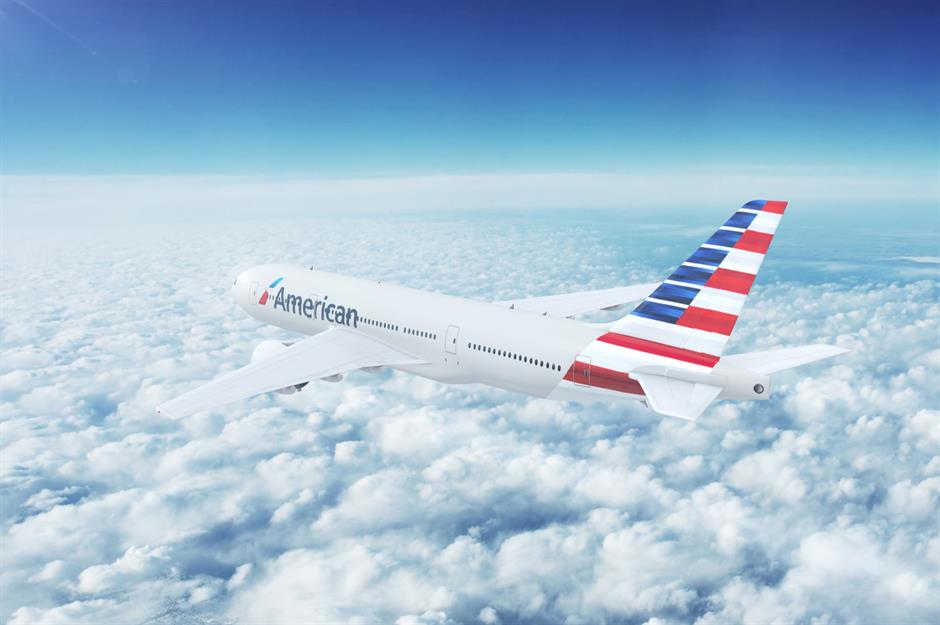
The main change in the last decade was the sheer volume of travellers: more and more people were flying than ever before, and the sky-high numbers had previously shown little sign of tailing off. In fact, in 2017, the International Air Transport Association had projected that there could be 7.2 billion air travel passengers by 2035.
2020s: grounded planes at Berlin-Brandenburg Airport, Germany
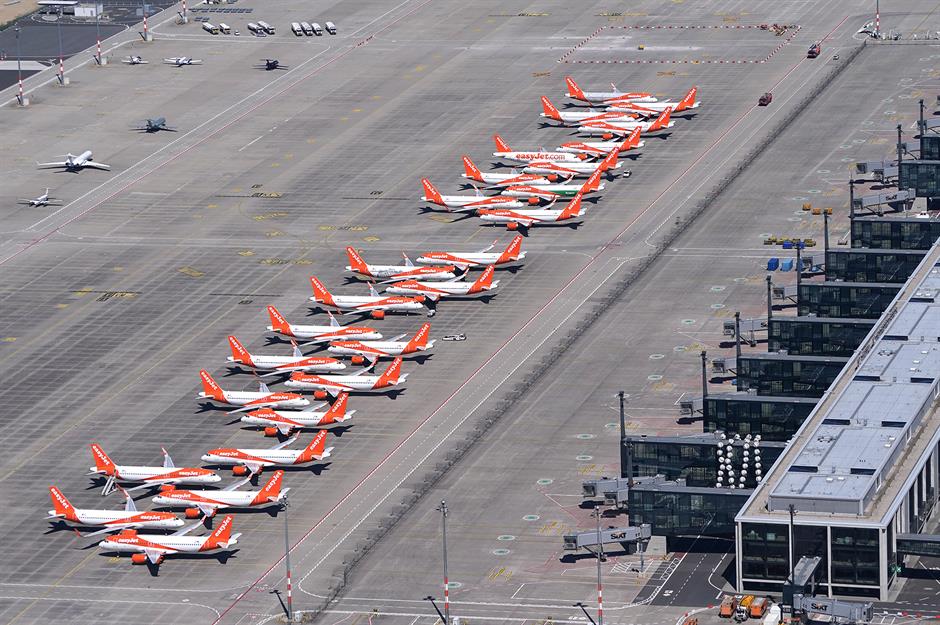
The COVID-19 pandemic rocked the travel and aviation industry and both passengers and staff had to adjust to a new (and unpredictable) ‘normal’. Ever-changing international travel restrictions left airlines up in the air (figuratively, not literally), and major players including easyJet, American Airlines and British Airways suffered severe financial losses, resulting in job cuts. This photo from 1 June 2020 shows out-of-service planes at Berlin-Brandenburg Airport.
2020s: a passenger undergoes a temperature check at Heathrow Airport
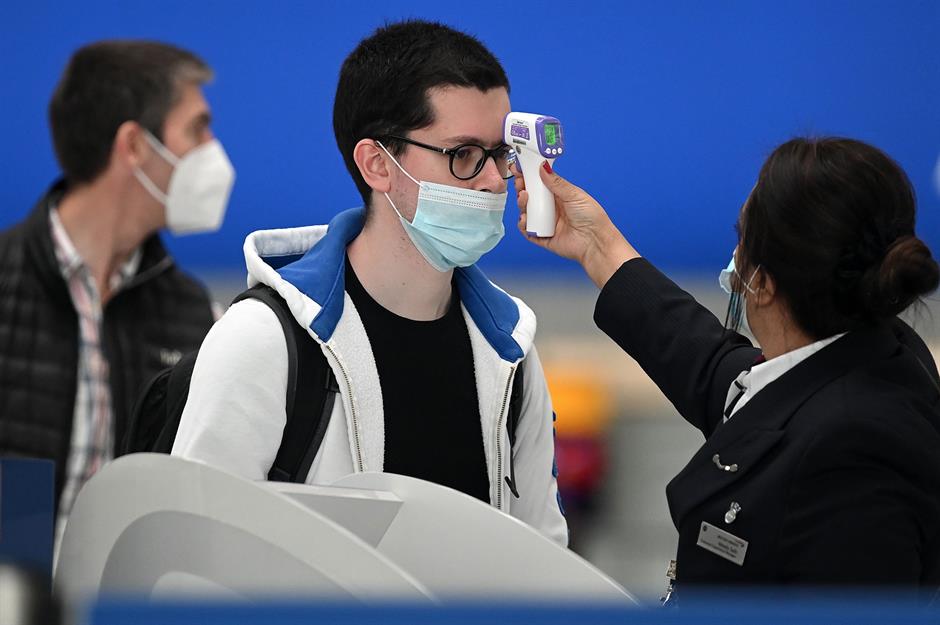
Towards the end of 2020, civil aviation began to resume at a crawling pace, with the announcement of some 'air bridges' or 'travel corridors'. For passengers choosing to fly, airport experiences looked rather different around the world. Protocols and restrictions have varied from airport to airport, and from airline to airline, over recent months, but have typically involved mandatory face coverings, contactless check-ins and fewer open airport facilities. A passenger is seen here in July 2020 receiving a temperature check at a BA desk at London’s Heathrow Airport.
2020s: a masked flight attendant on a Brussels Airlines plane
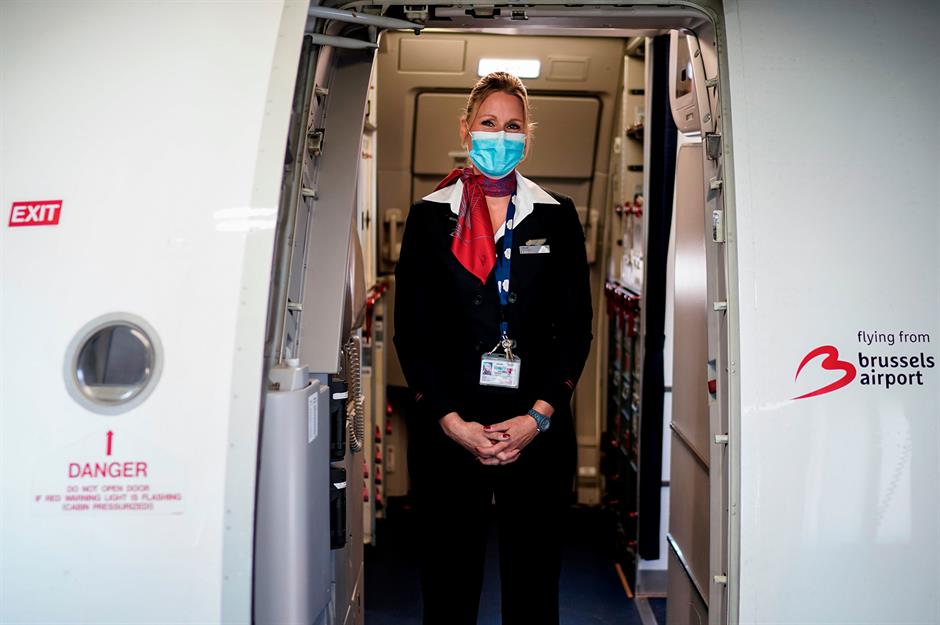
Passengers had to get used to new onboard experiences too. Depending on the airline – and in efforts to reduce touch points and contact between staff and passengers – changes were extended to a lack of inflight meals or trolley services, and the reduction of little luxuries like in-flight magazines, blankets and the like. Masks were mandatory on most flights too, while some carriers blocked the middle seats to allow passengers more space.
2020s: international air travel gets a slow lift off
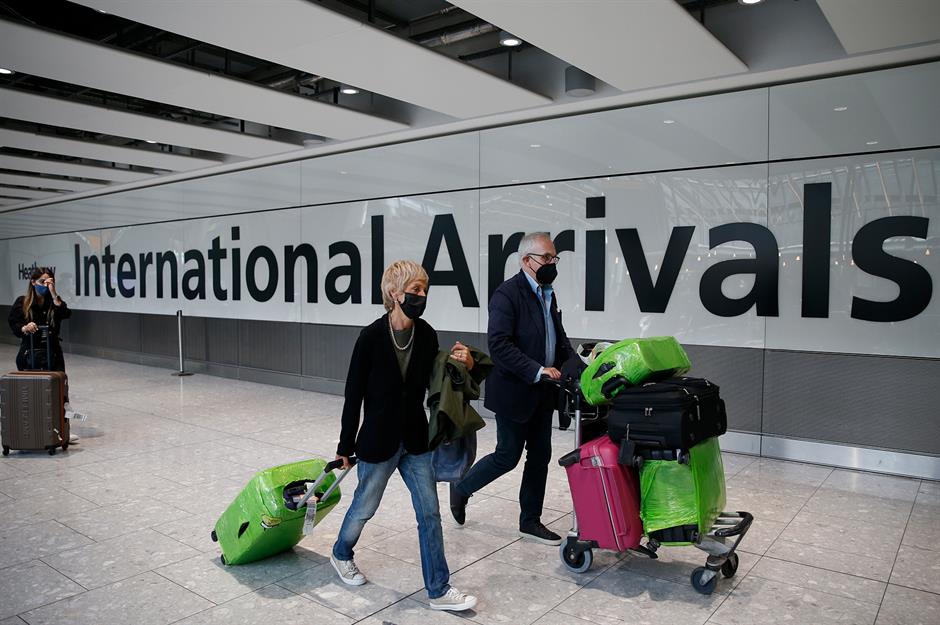
The aviation industry continued to feel the effects of the COVID-19 pandemic into 2021, though the International Air Transport Association (IATA) predicted a 50.4% uptick in demand for flights from 2020. With vaccine programmes being rolled out around the world, international borders have finally opened.
2020s: a passenger holds up an EU 'vaccine passport'
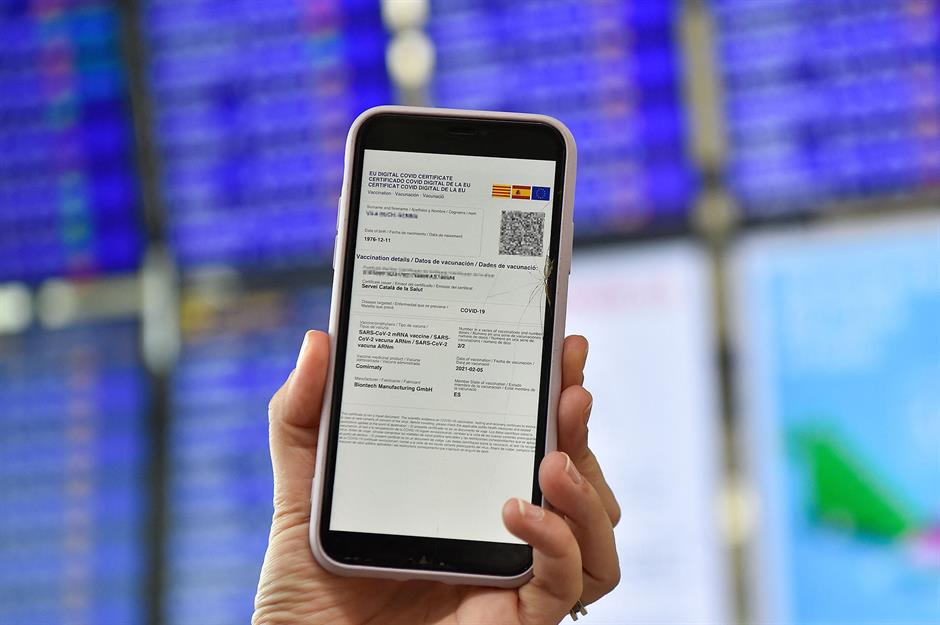
Around the world, testing and vaccines built bridges between destinations in staggered phases. For example, Canada’s borders first opened to double-jabbed Americans, before being unlocked for vaccinated travellers from around the world too. Double-jabbed UK travellers initially could fly to 'amber' European hotspots including France, Spain and Portugal without quarantining on return (though they had to take PCR tests). New Zealand and Australia also formed a 'quarantine-free travel bubble'. EU citizens could download a vaccine 'passport' (pictured) allowing them to cross EU borders with minimal restrictions.
2020s: world's first all-electric plane takes to the skies
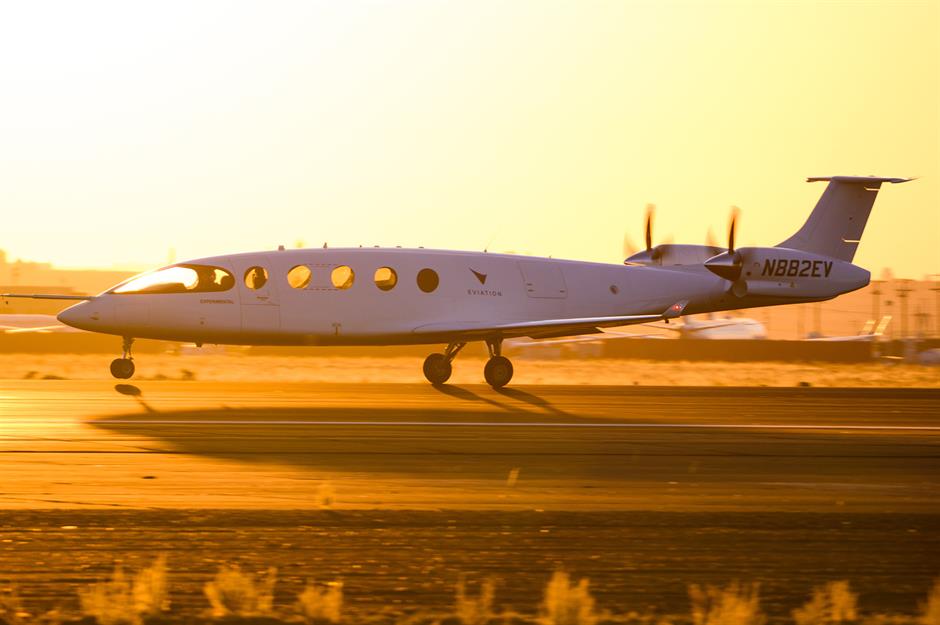
In late September 2022, the world's first all-electric plane jetted off for an eight-minute flight above the skies of Washington, USA. Alice, the project name that stuck during planning in 2016, is the brainchild of American-based company Eviation, and is slated to be fit for both passenger and cargo use by 2027. The successful maiden flight reached an altitude of 3,500 feet (1,067m) and the zero-emissions plane was powered by two 640-kilowatt electric motors. It is hoped Alice will operate flights ranging from 150 miles (240km) to 250 miles (402km), and will come in three different configurations: a nine-passenger commuter, a six-seater executive cabin and an eCargo version.
2020s: relaxed uniform policies are welcomed
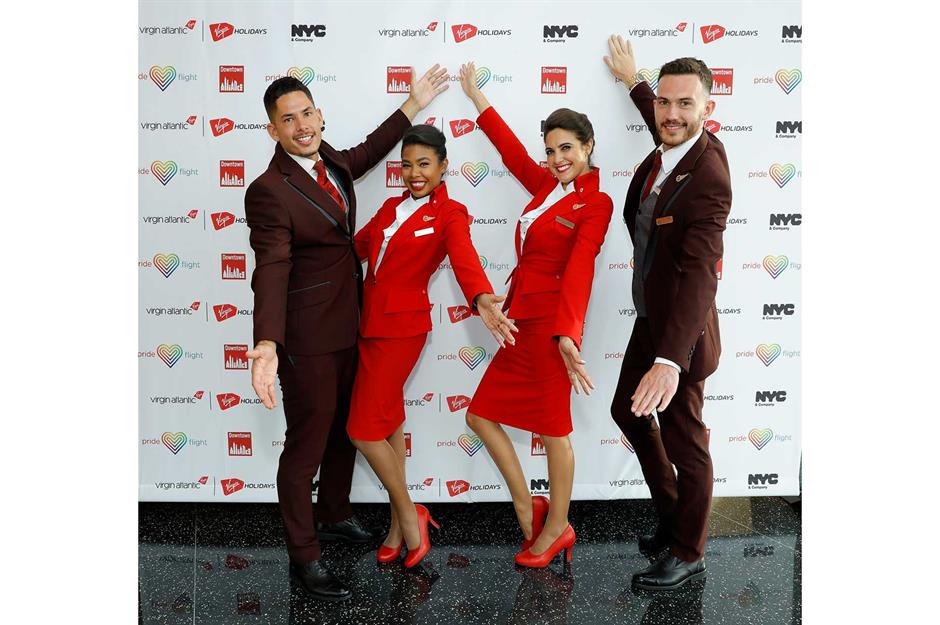
Cabin crew requirements have changed over the decades; as we've seen already, the 1930s followed strict rules regarding age, height and weight, and since then tailored uniforms and specific hairstyles became the norm. But the 2020s have welcomed a more relaxed approach and in September 2022 Virgin Atlantic ditched gender-specific uniforms allowing crew, pilots and ground staff to choose whichever they feel most comfortable in. Earlier in the year staff were also permitted to keep their tattoos visible, becoming the first UK airline to do so.
2020s: airline trials biometric check-in
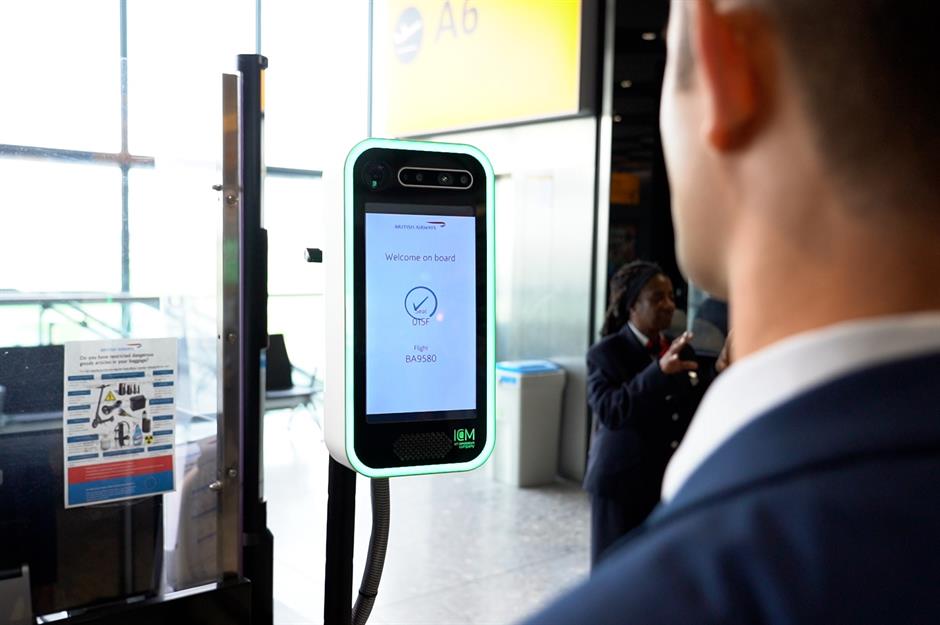
'Don't forget your passport' has long been the golden rule of air travel, but a system trialled in 2022 by UK carrier British Airways may ultimately see passengers breeze through airports with just a boarding pass and a smile. The trial, rolled out at Heathrow Terminal 5 for flights between London and Malaga, Spain, saw customers scan their faces and their passports on their smartphone prior to arriving at the airport, where 'Smart Bio-Pod cameras' will verify their identity in under three seconds, allowing them to keep their passports safely stowed. The programme ran for six months.
2050: air travel industry set to become carbon neutral
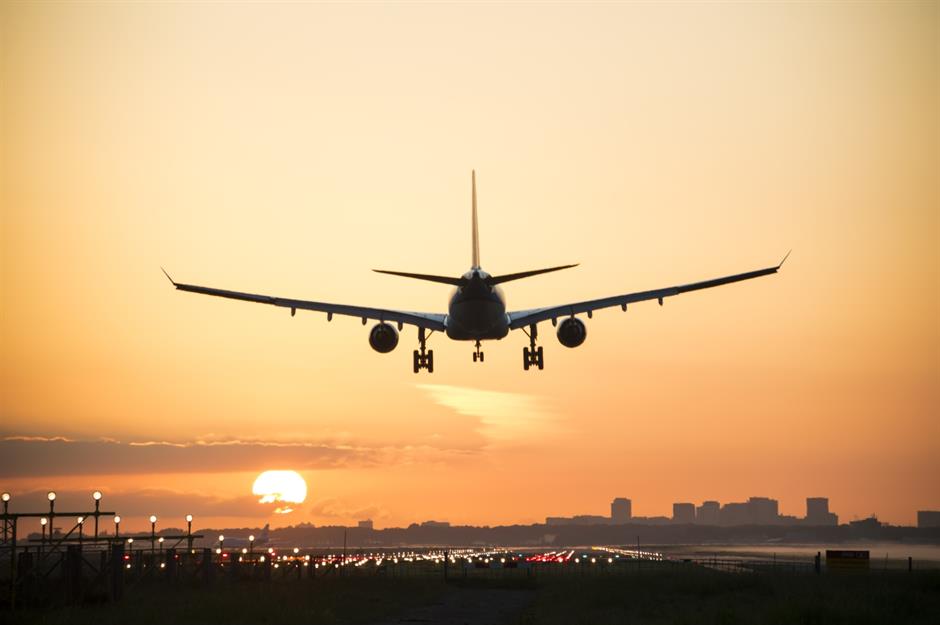
We don't know for sure what the future holds for air travel. But the International Civil Aviation Organisation (ICAO) recently announced its support for a net zero goal for the aviation industry by 2050. However, environmental campaigners say the plans don't go far enough, believing more measures were needed to ensure the 193 member countries of the ICAO meet the goal and hold airlines accountable.
Now check out groundbreaking planes that changed how we travel
Comments
Be the first to comment
Do you want to comment on this article? You need to be signed in for this feature